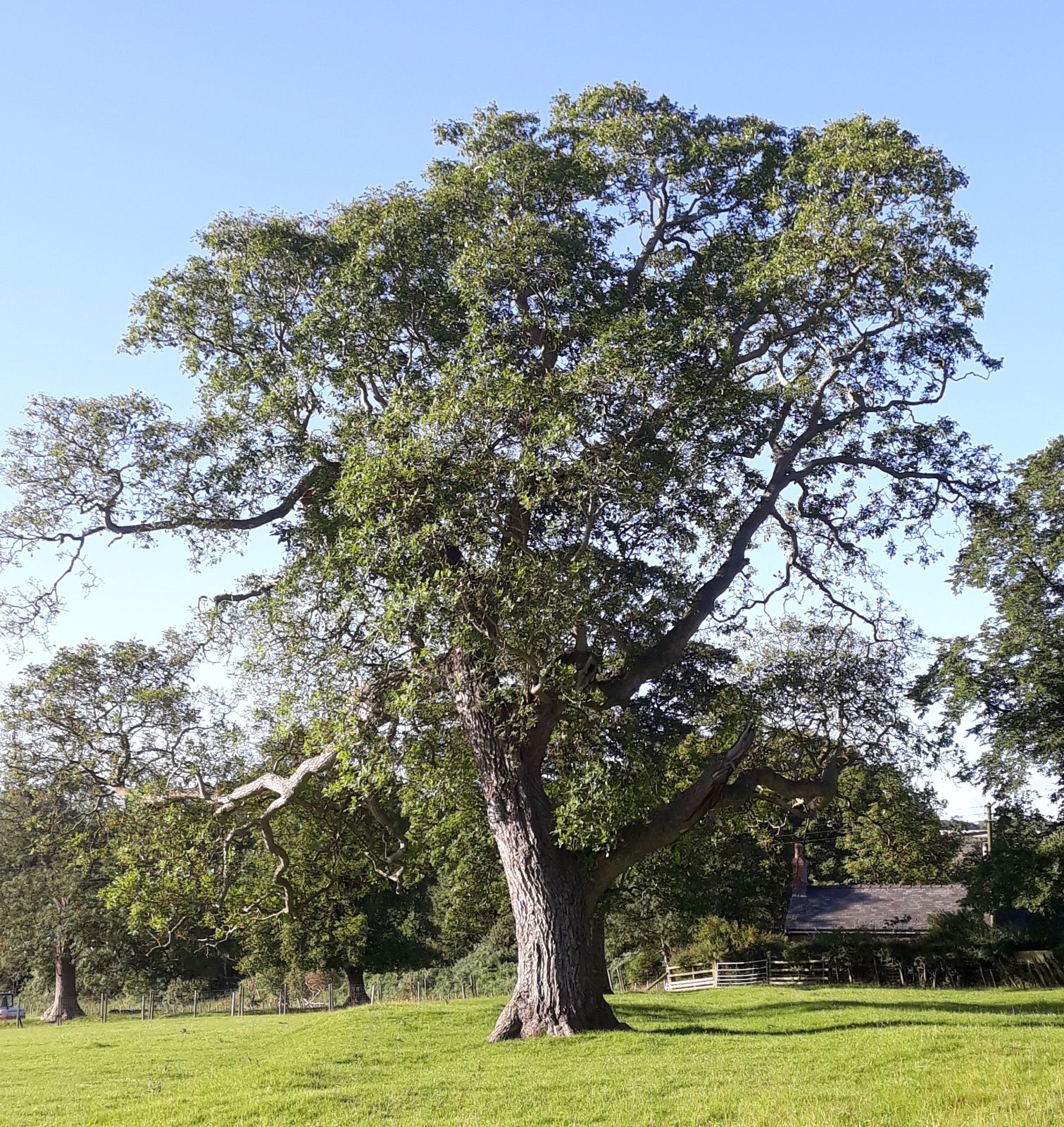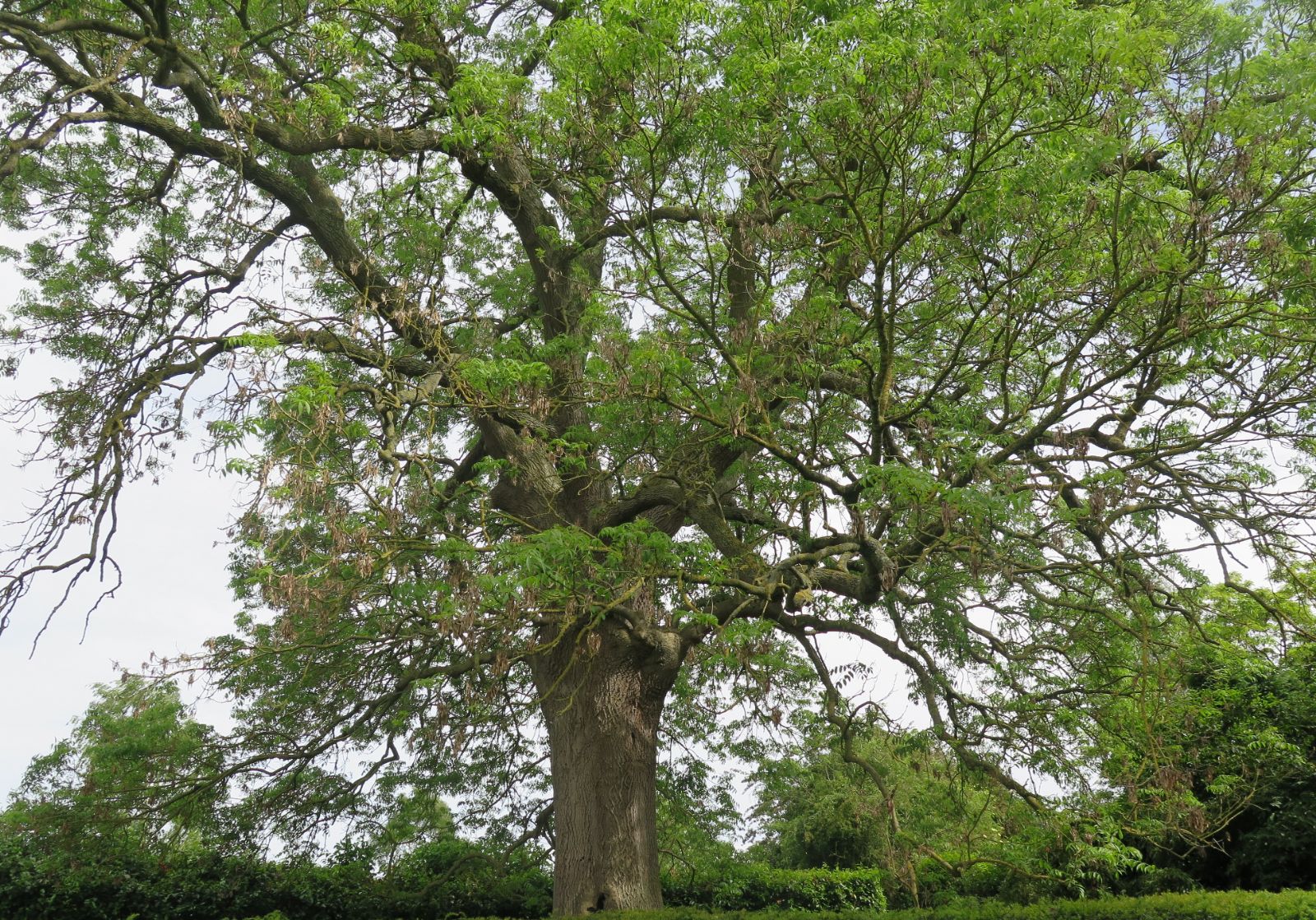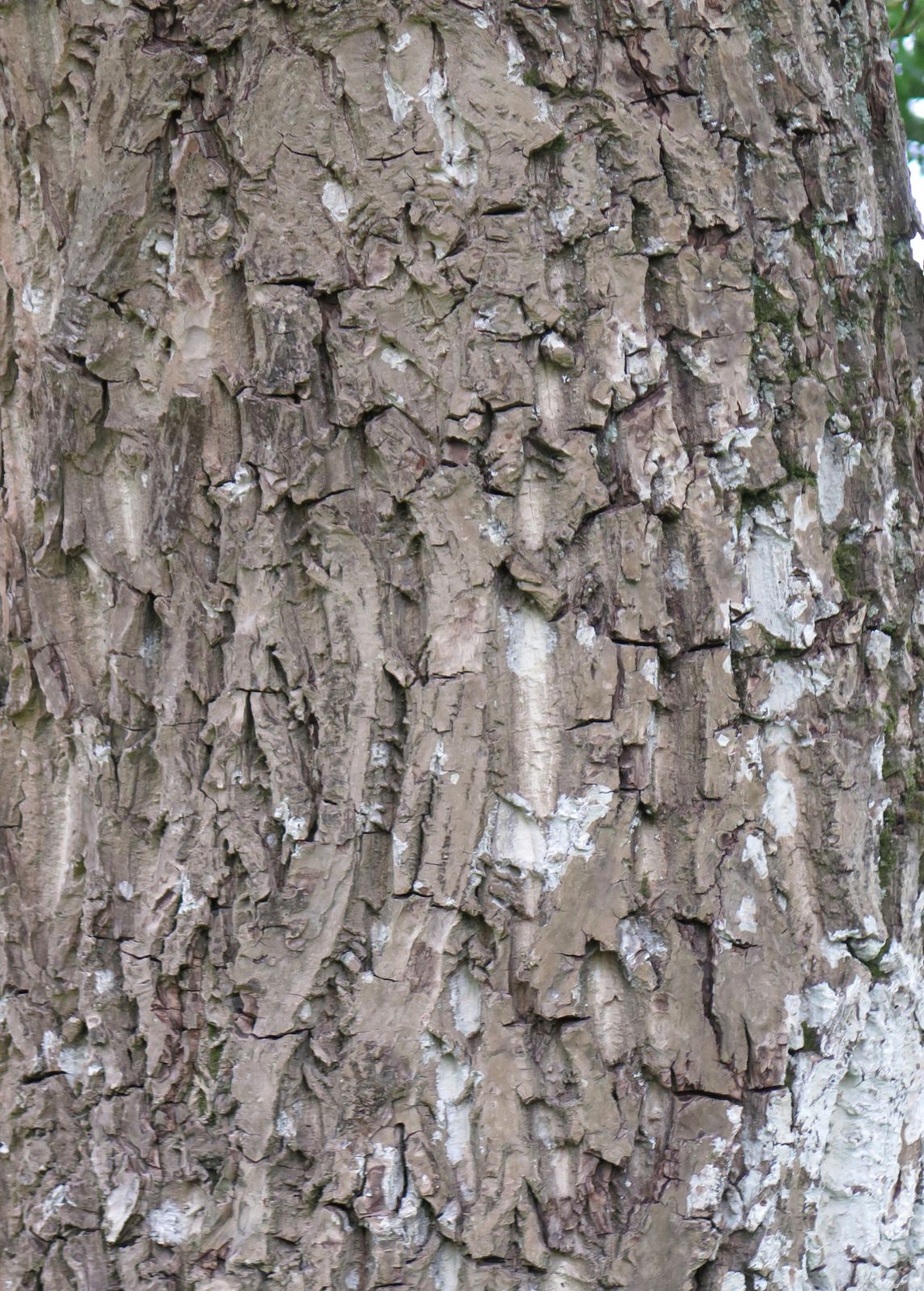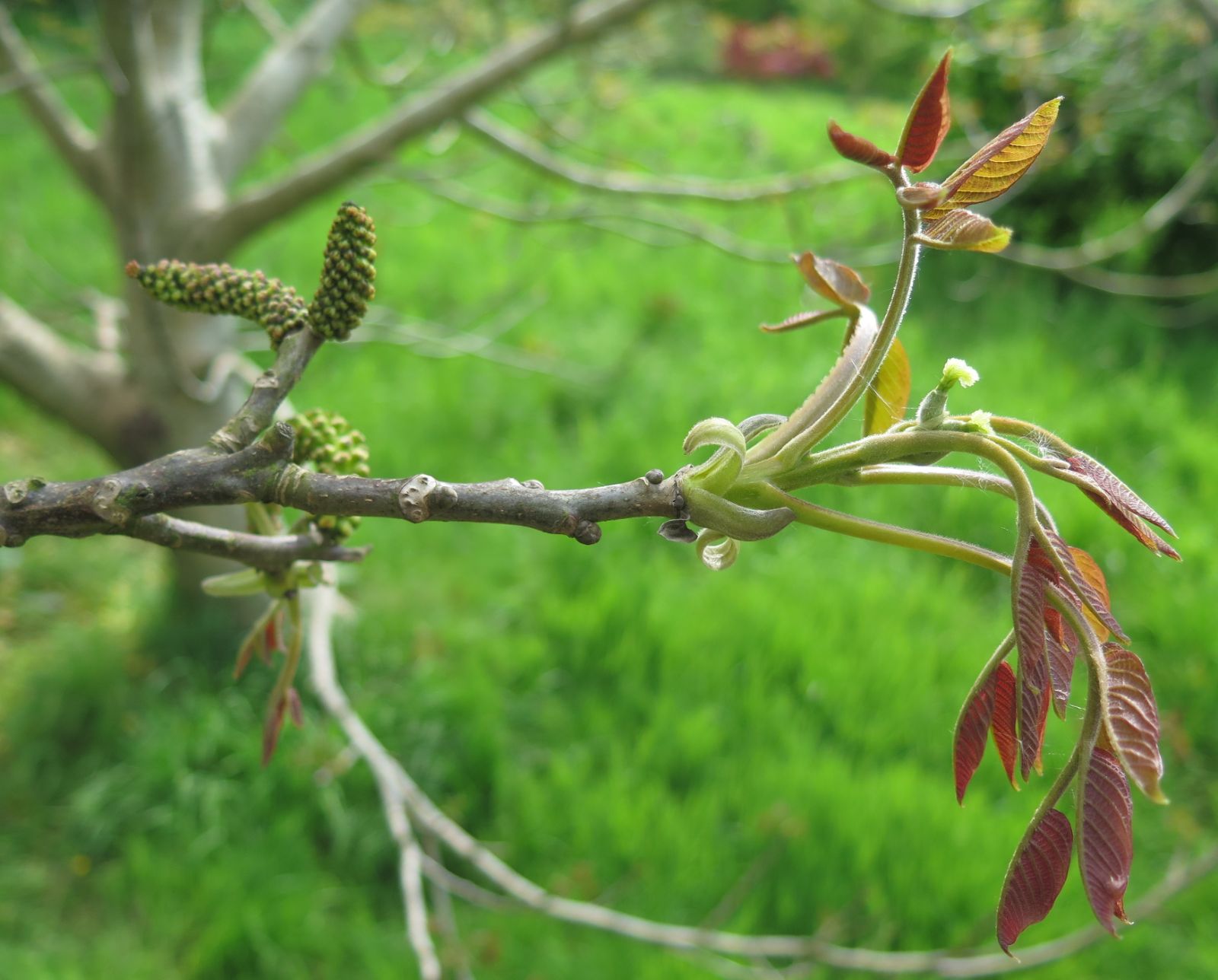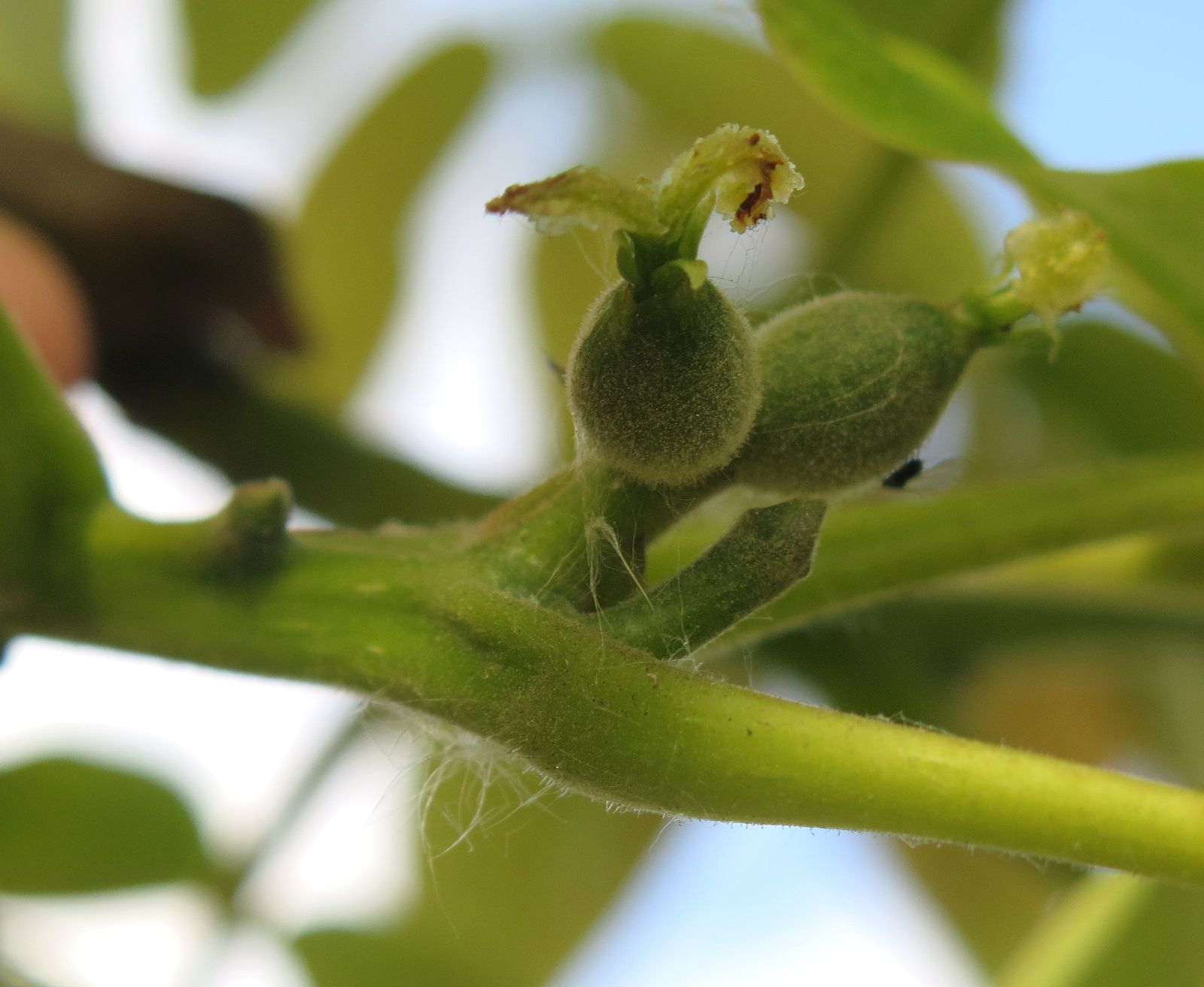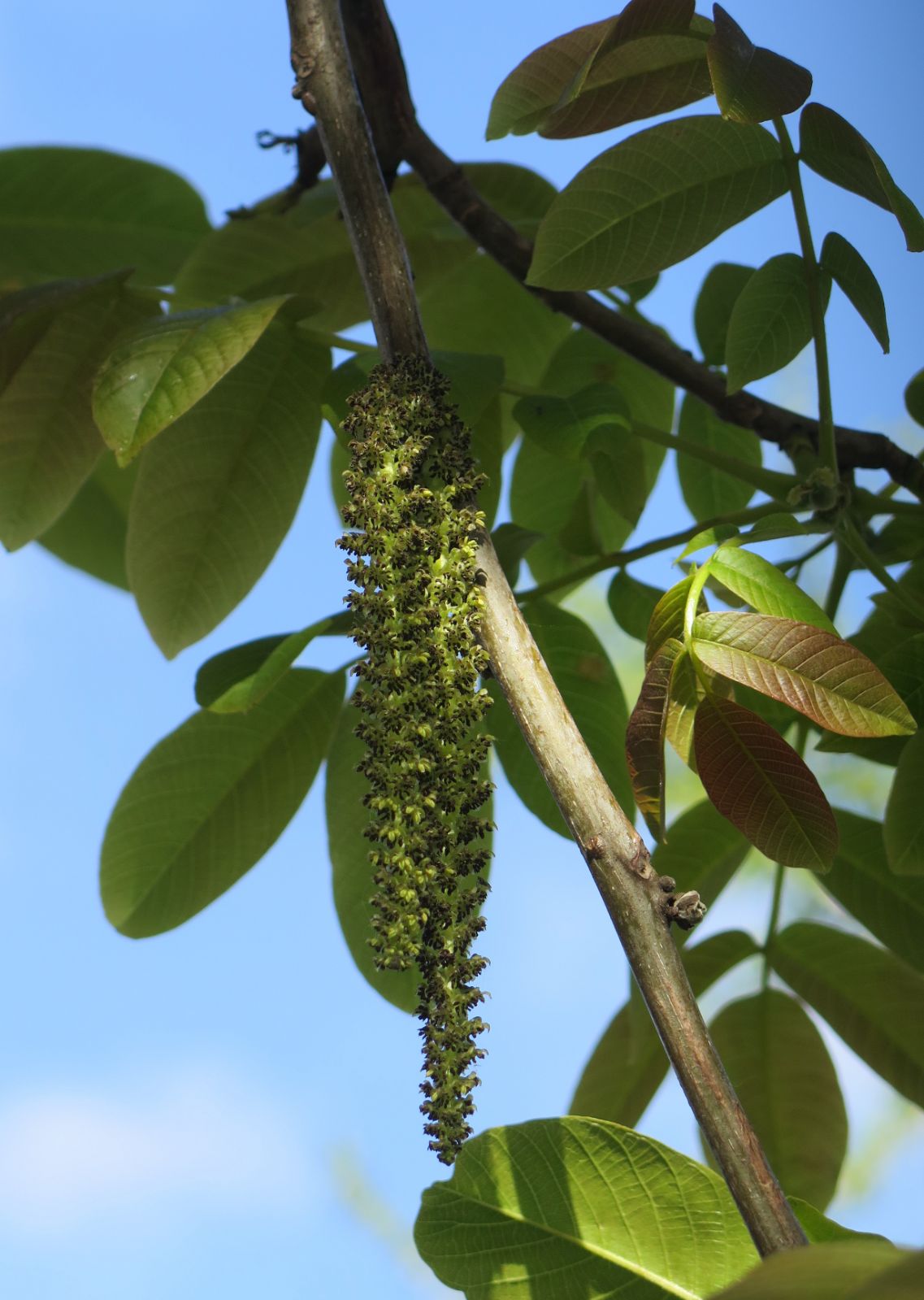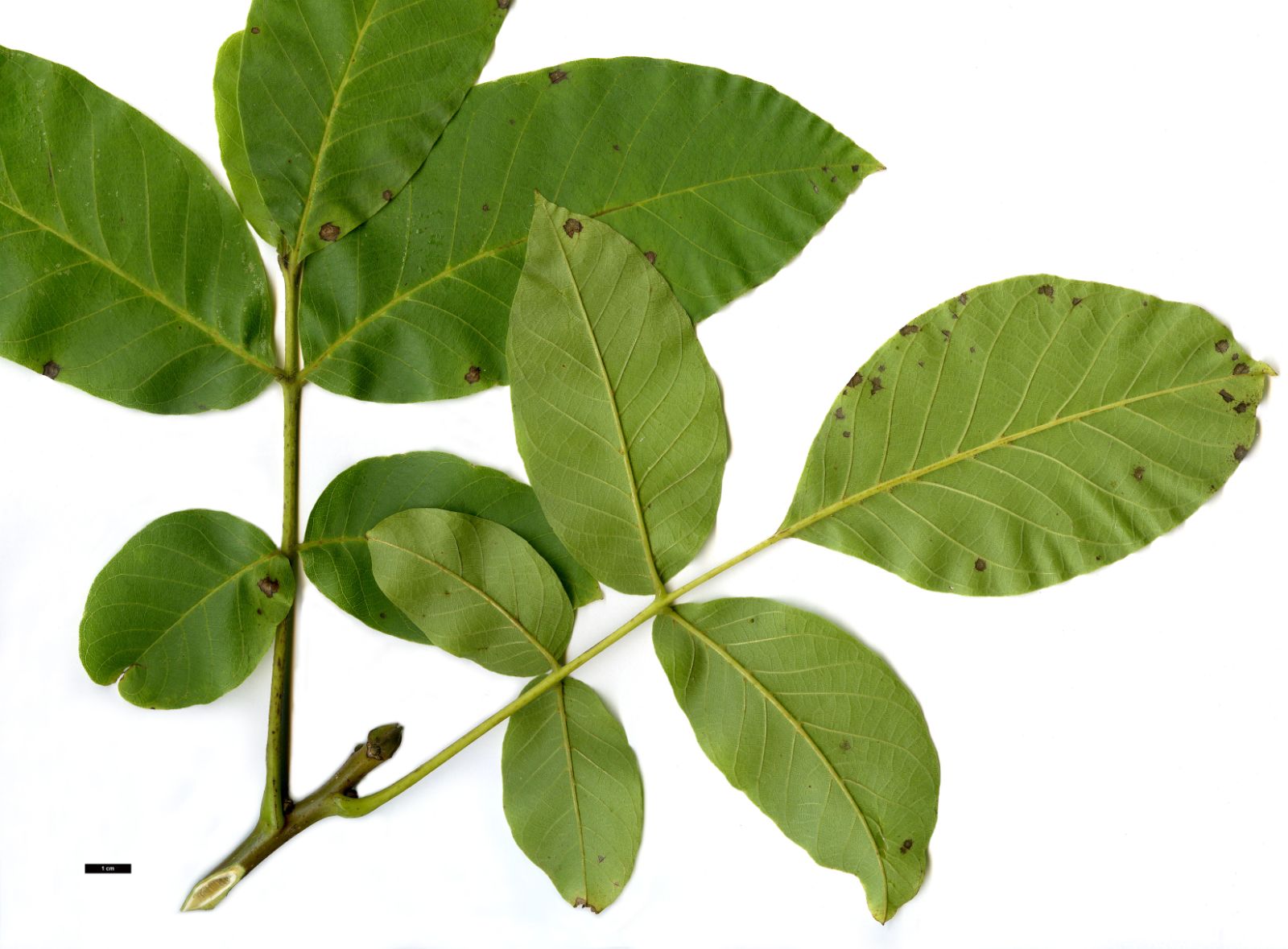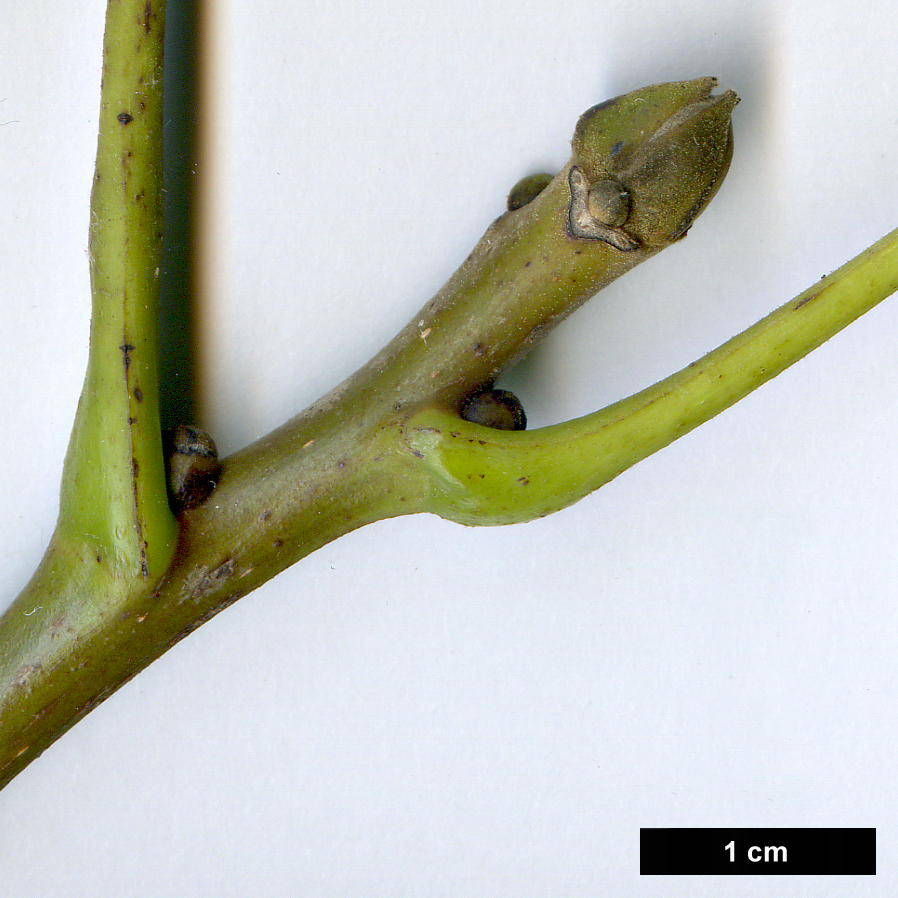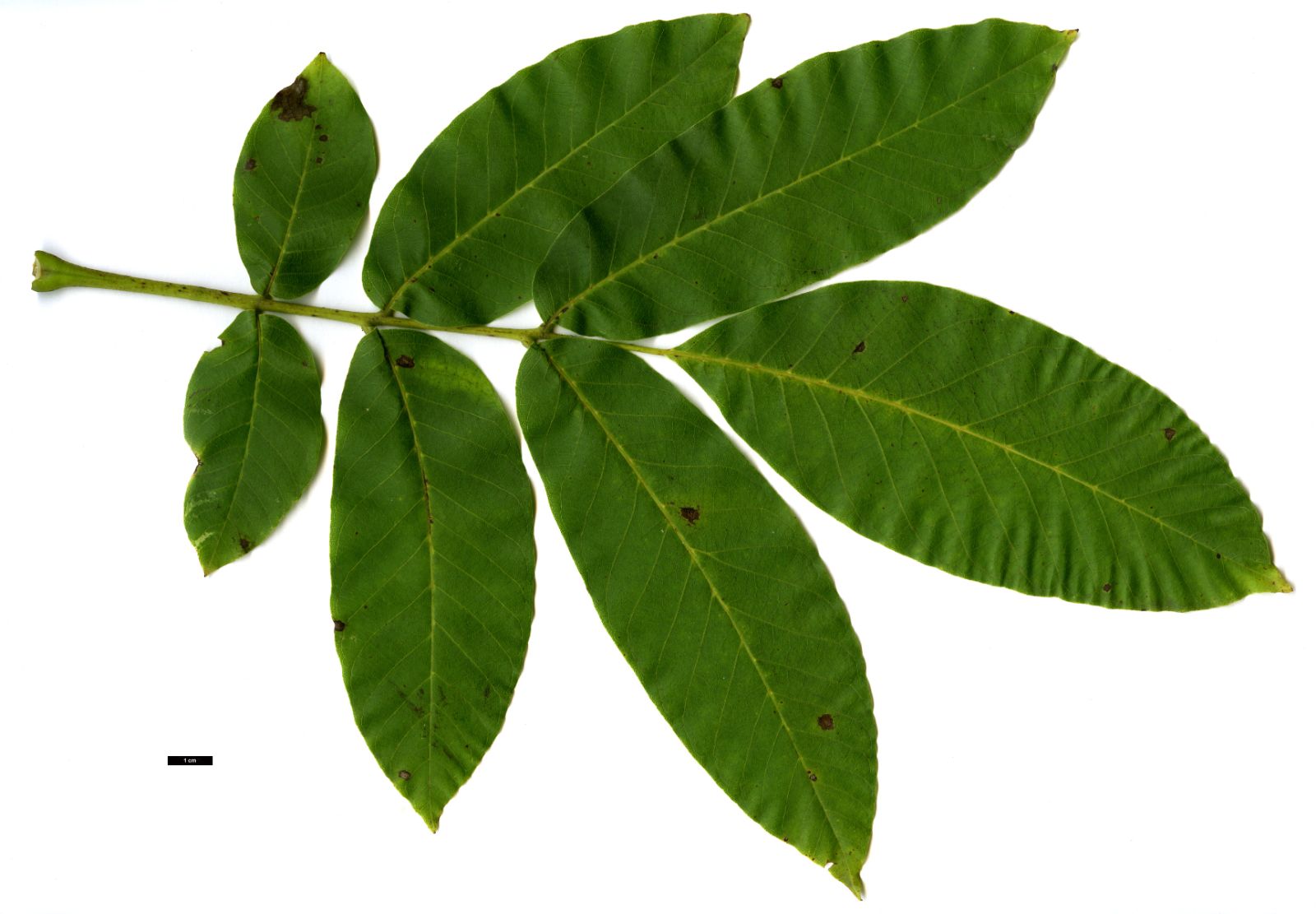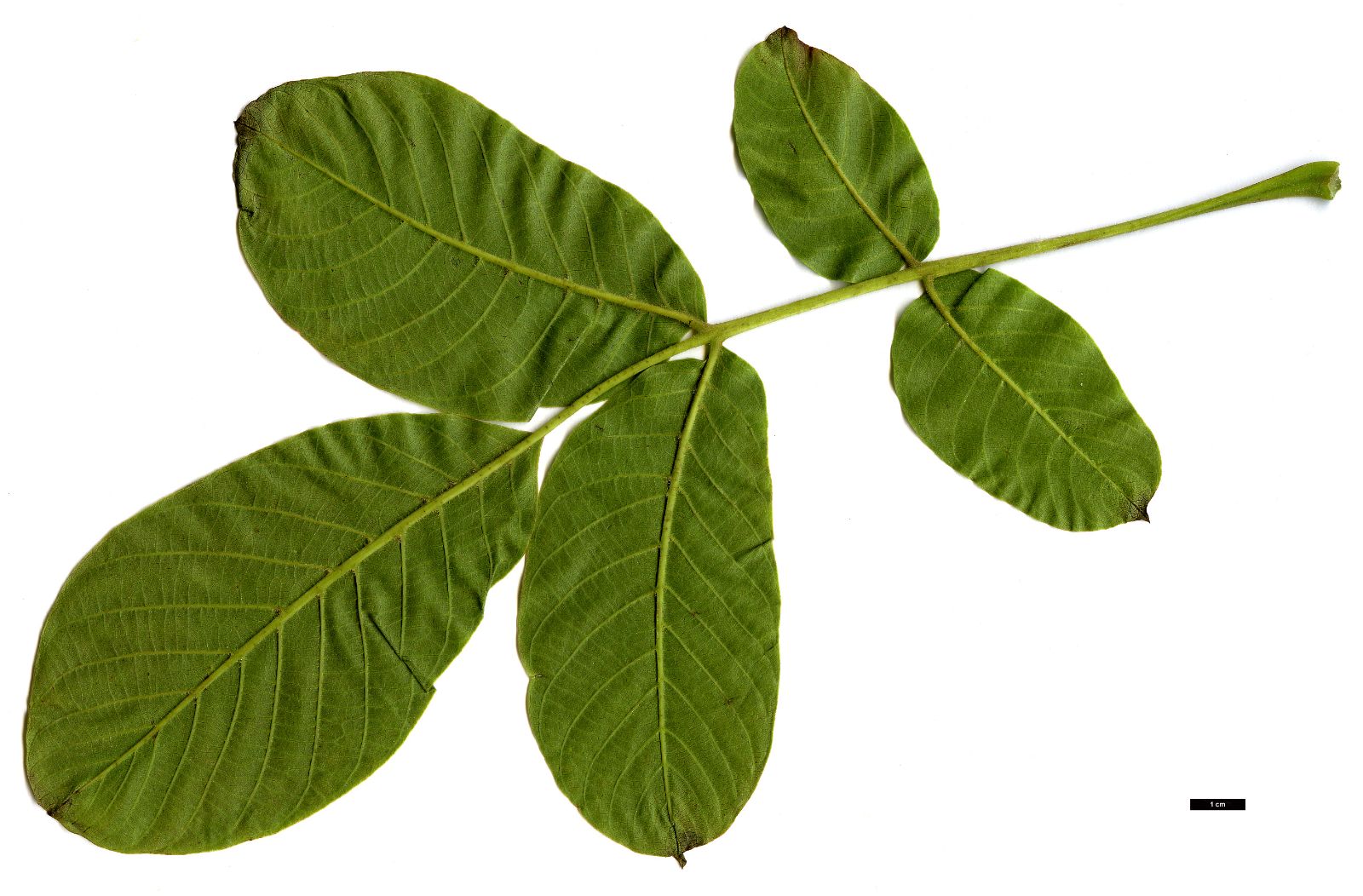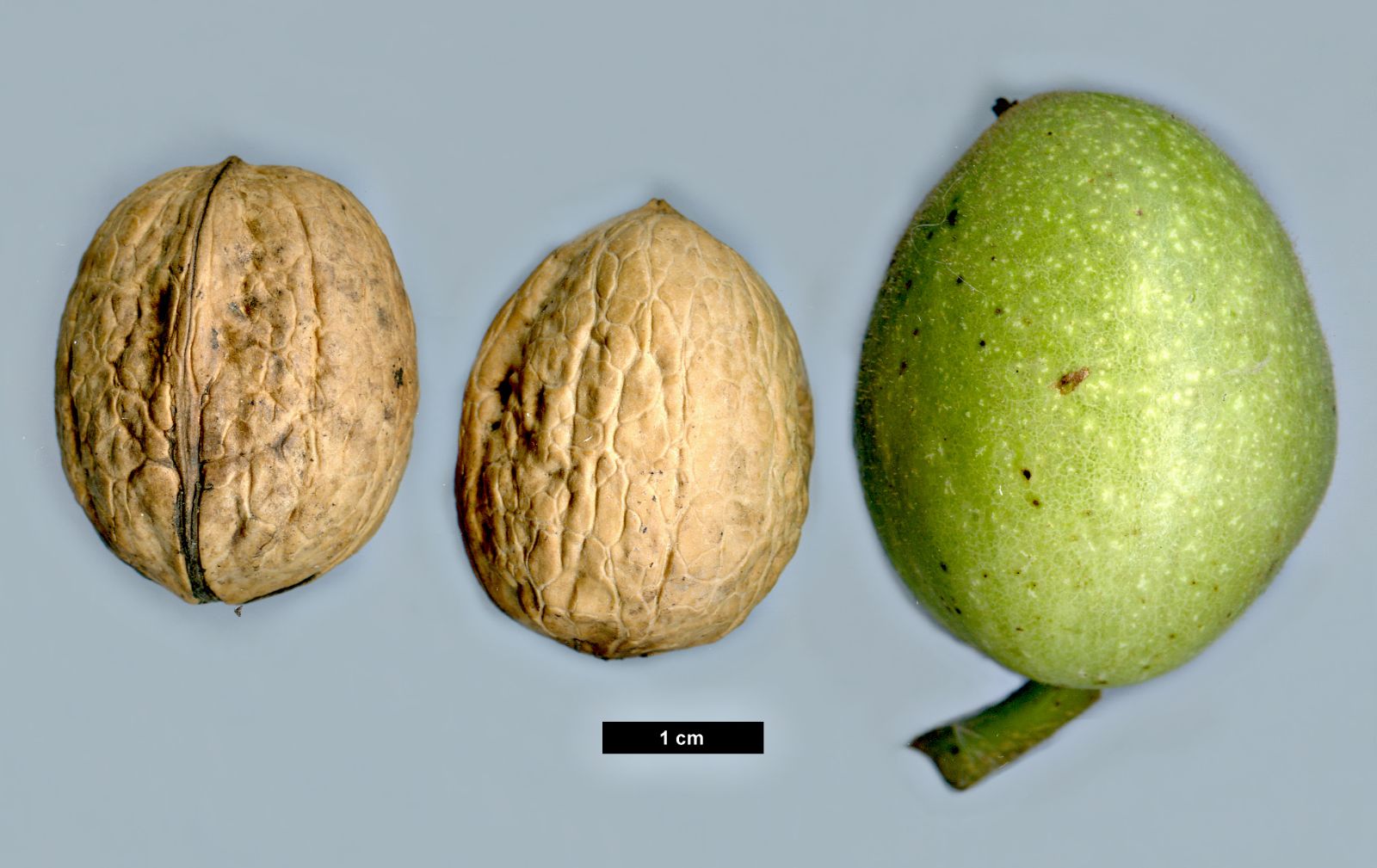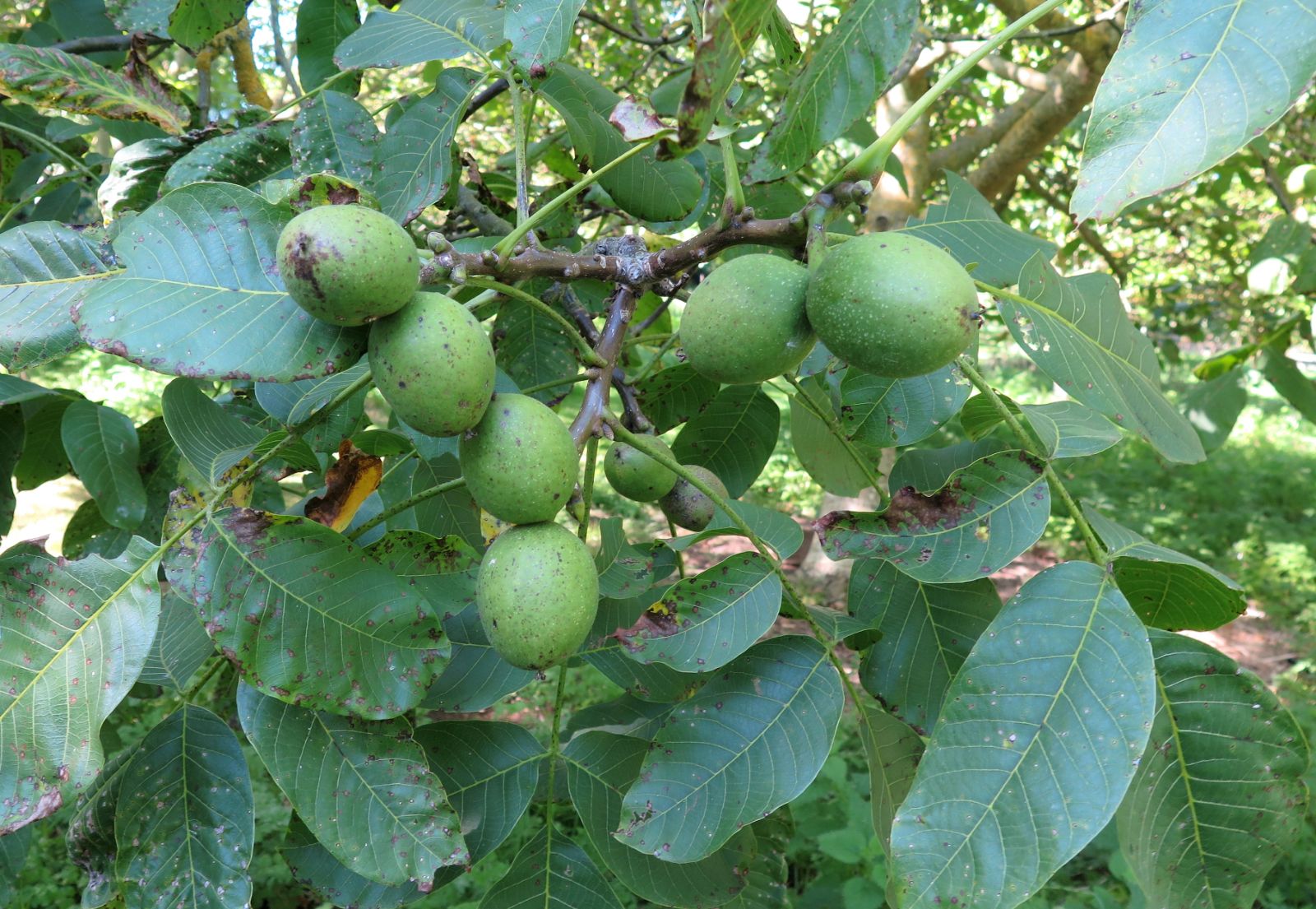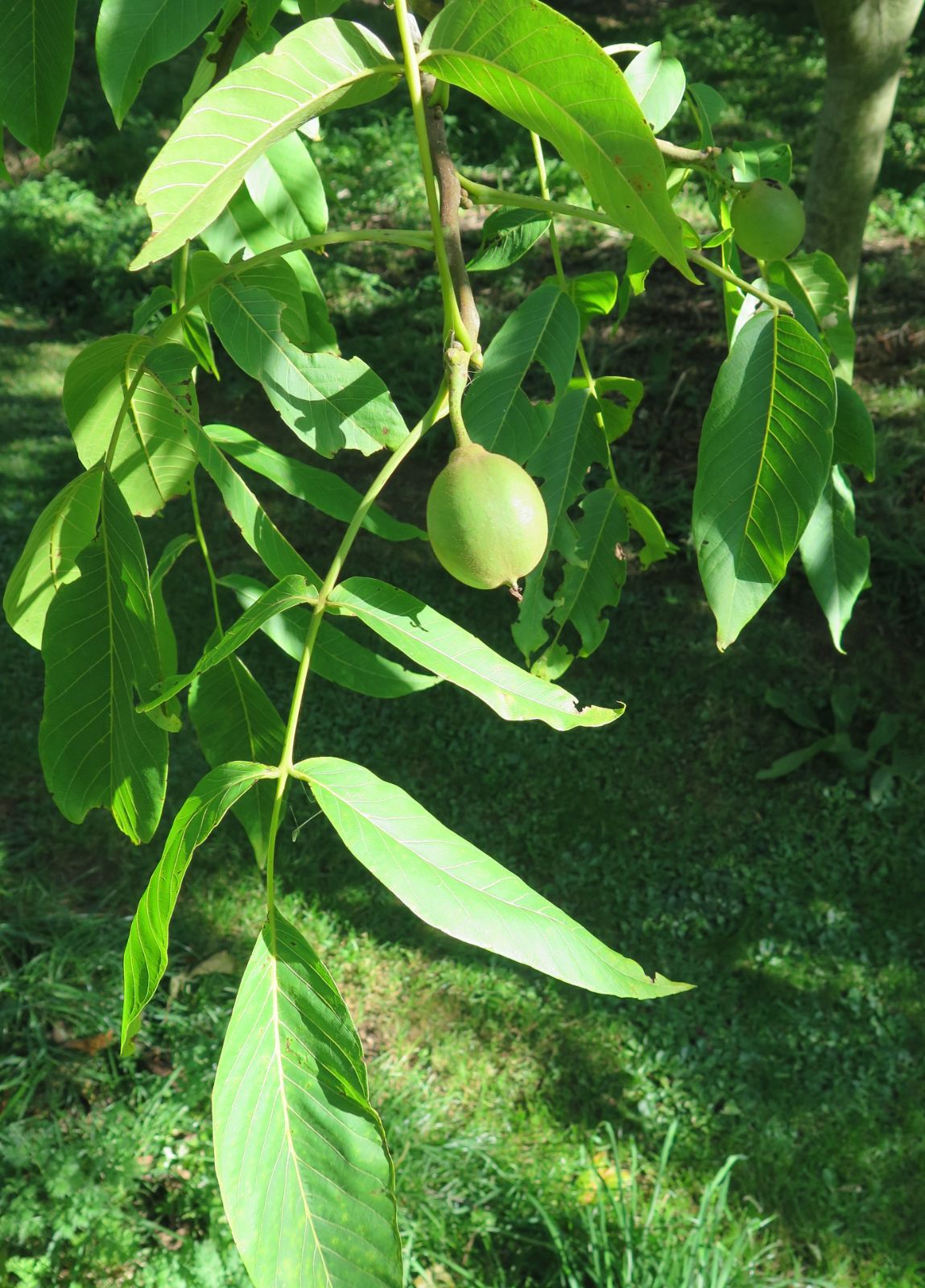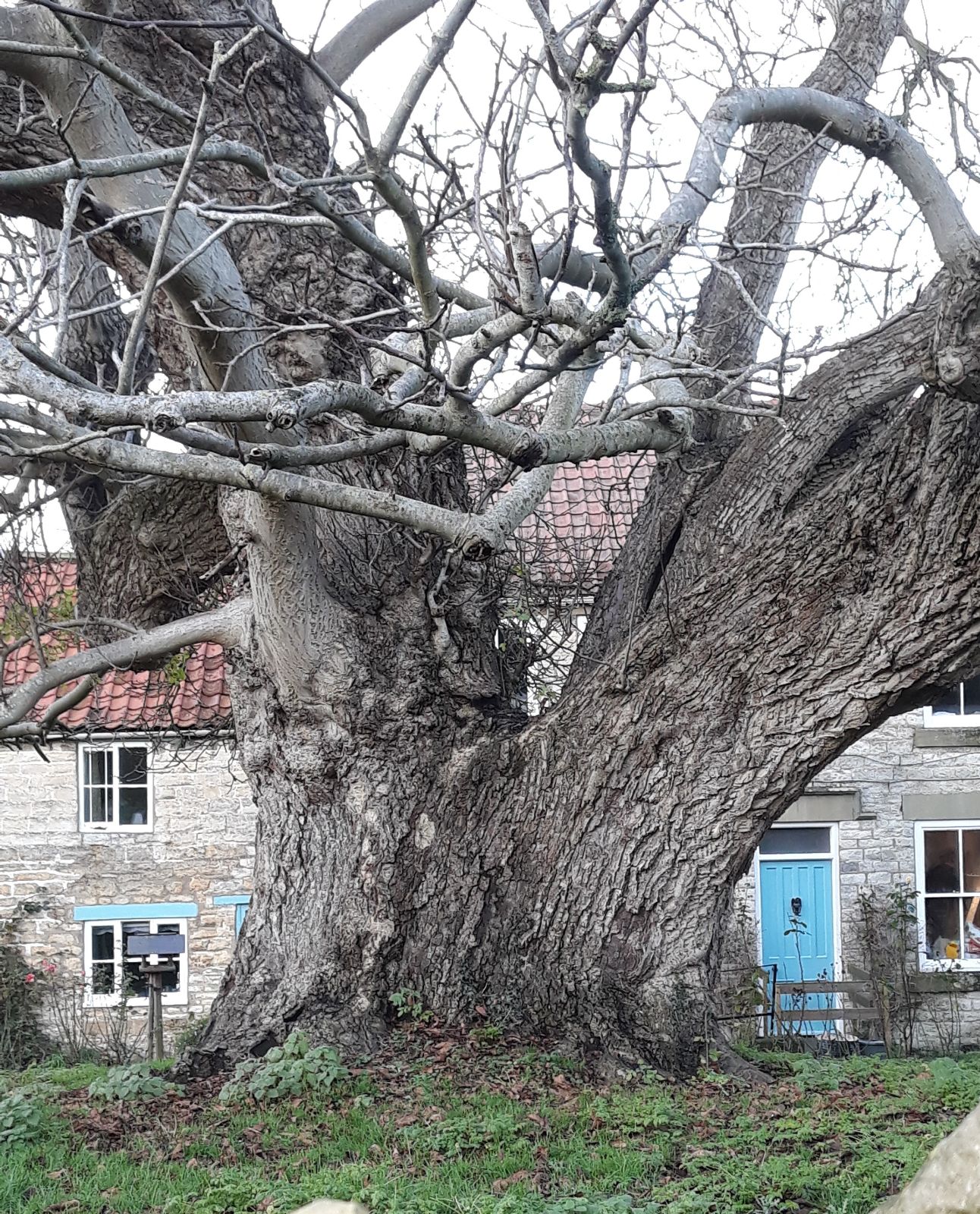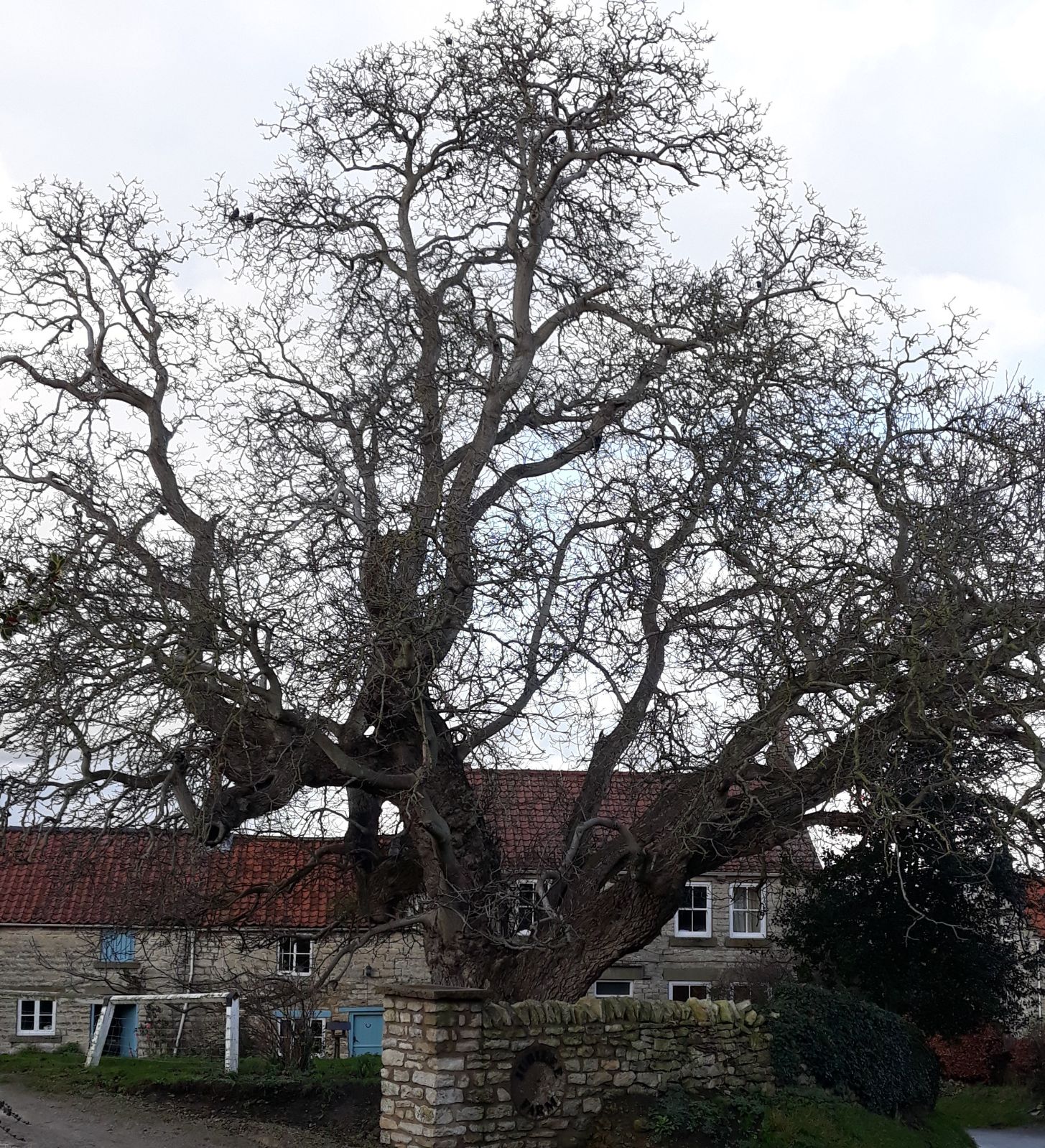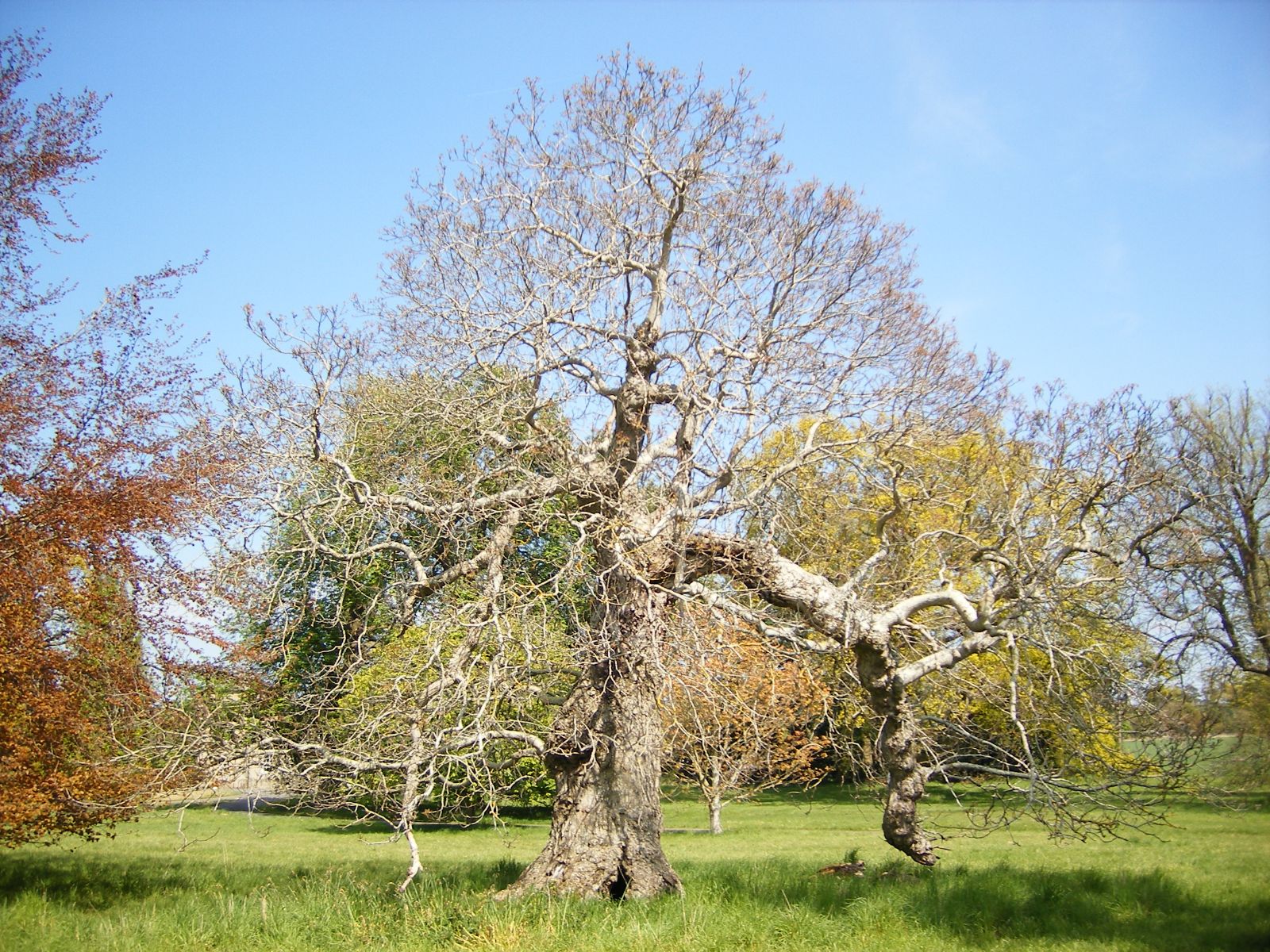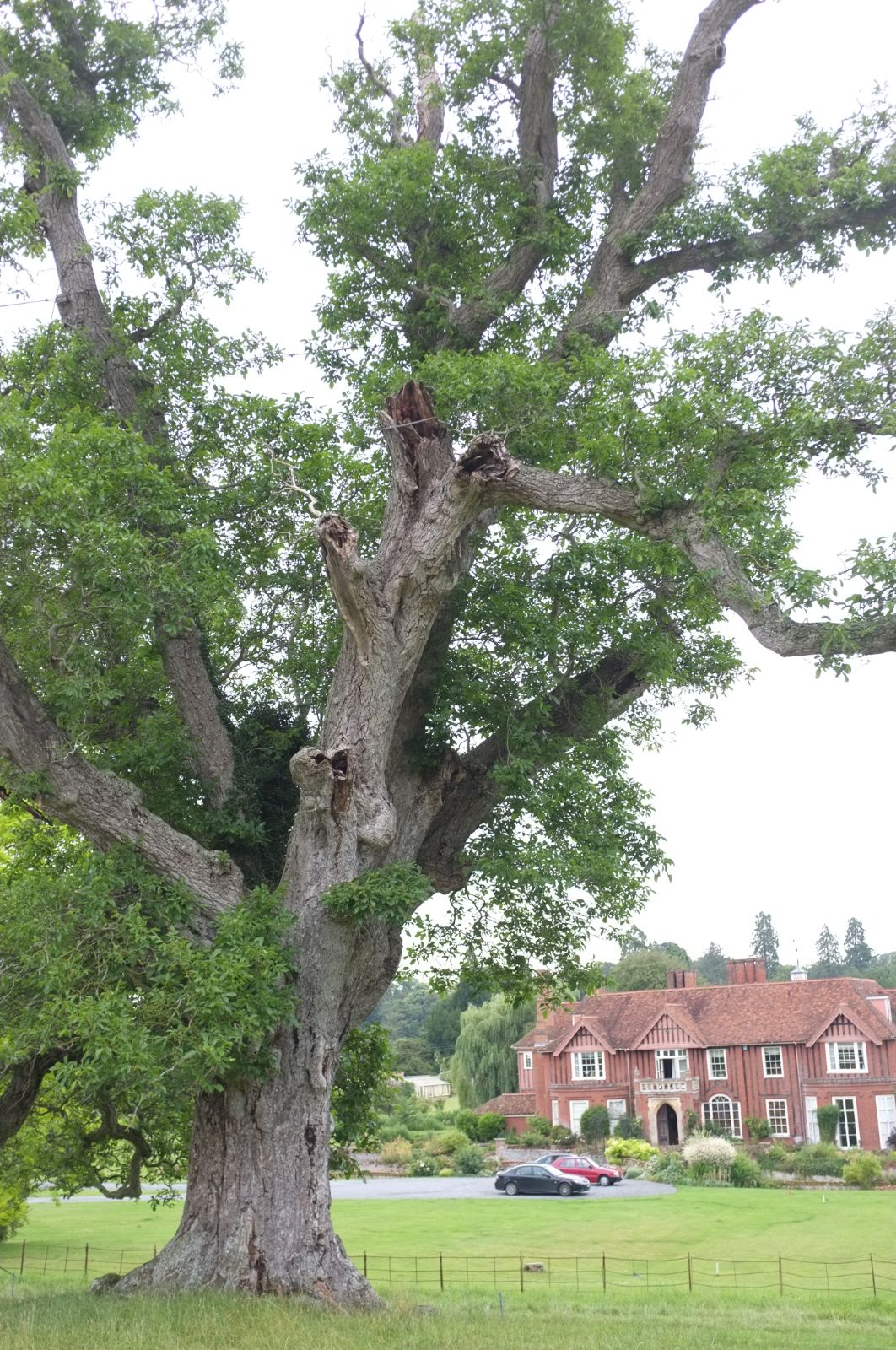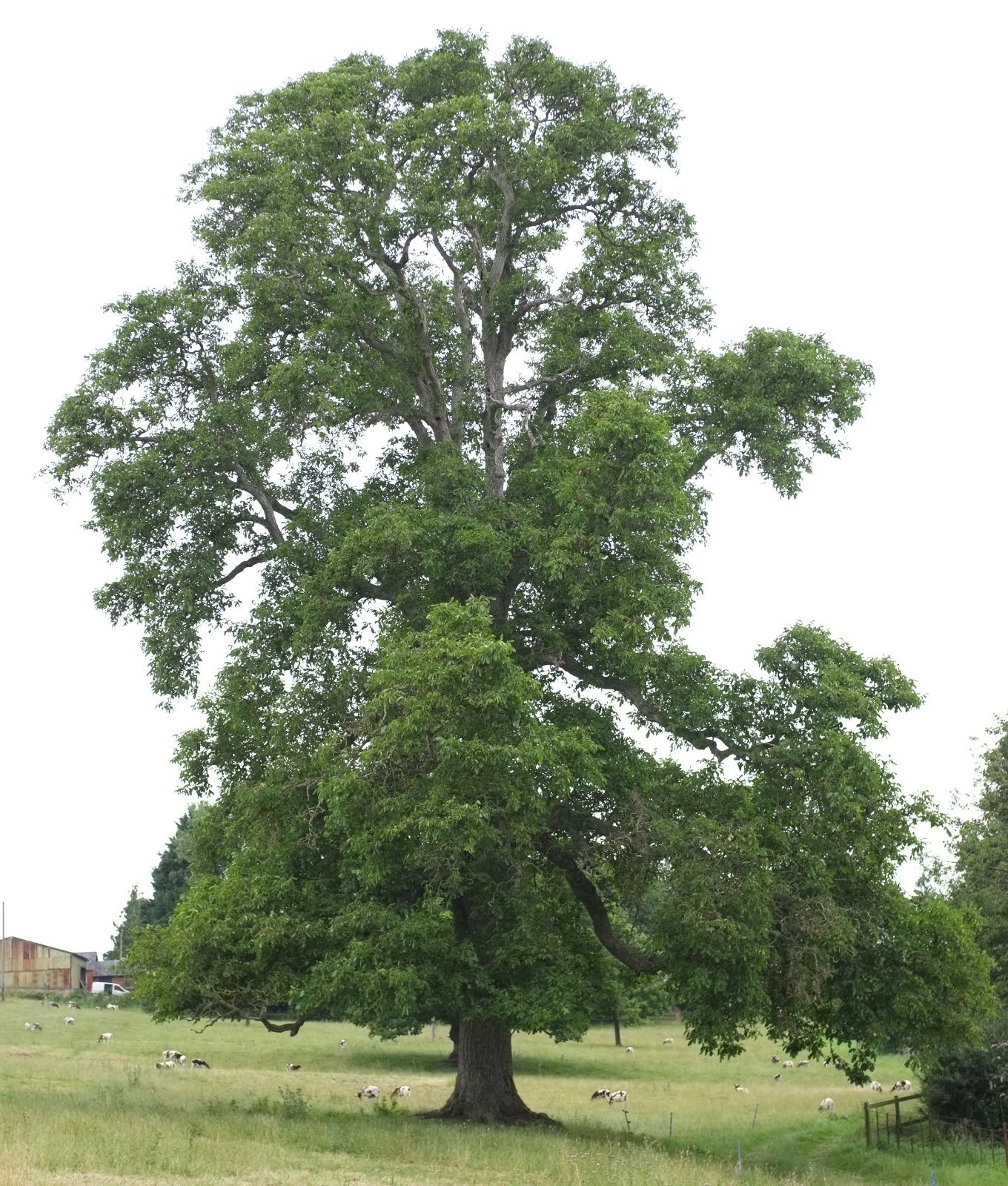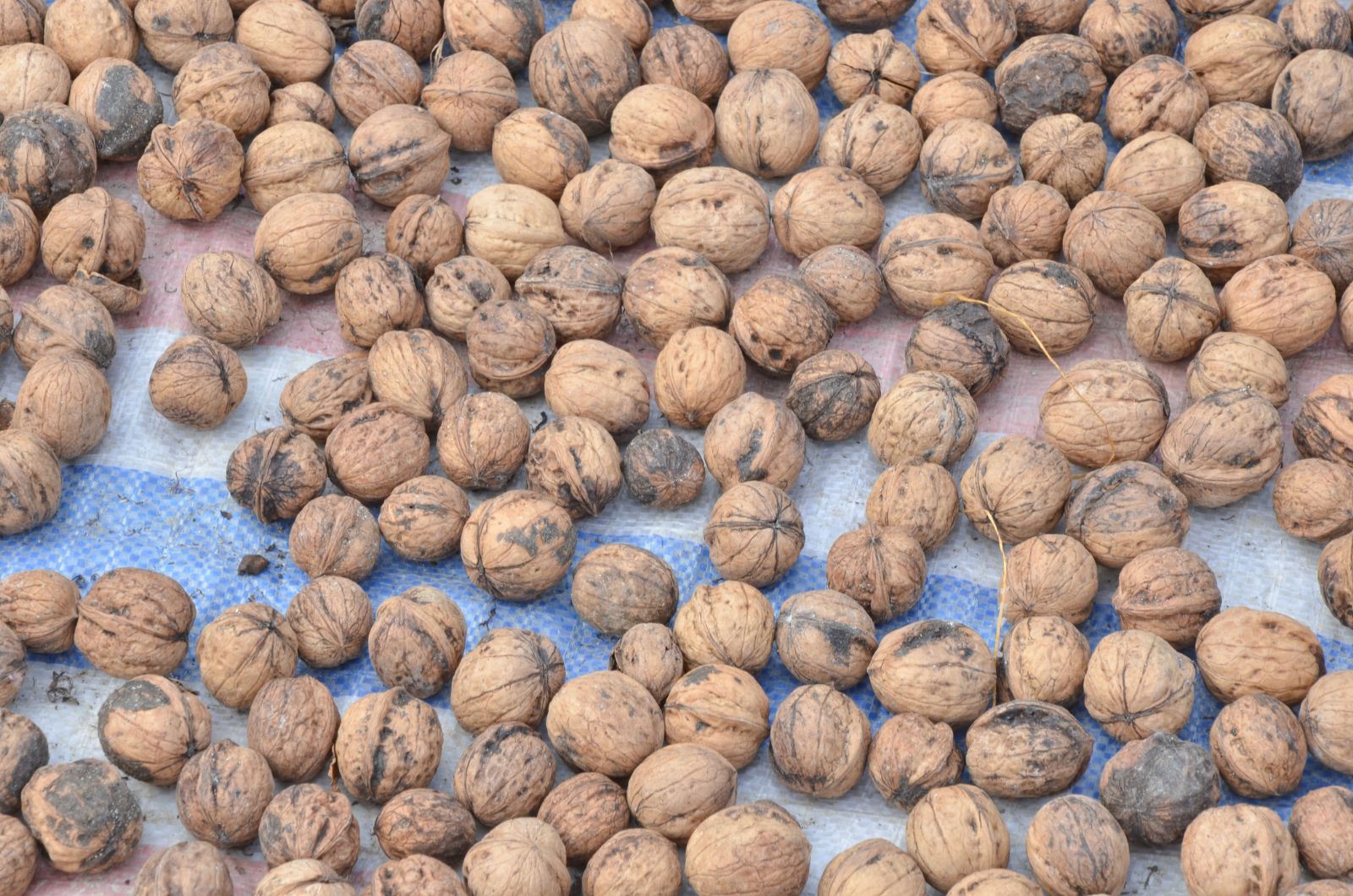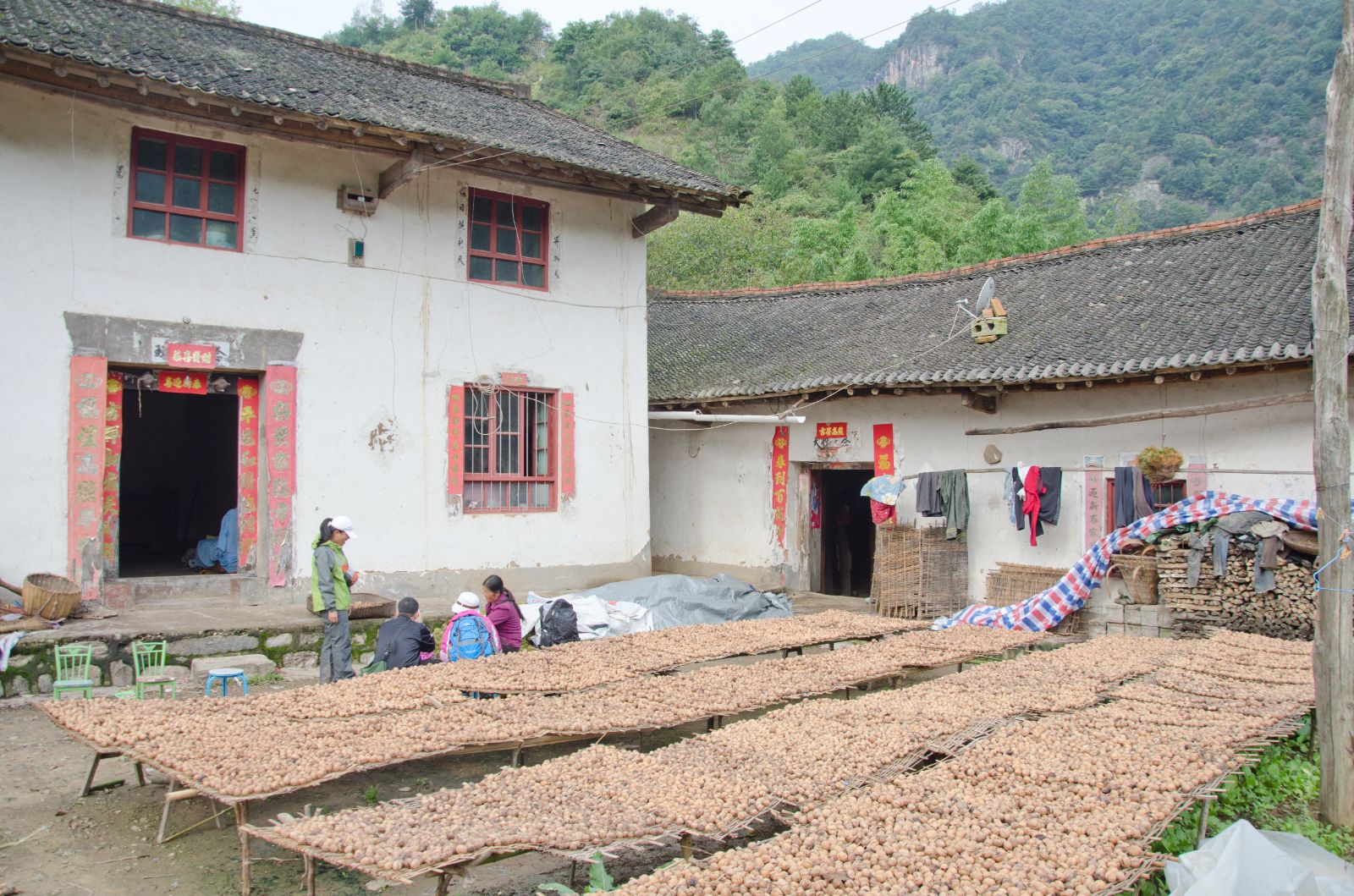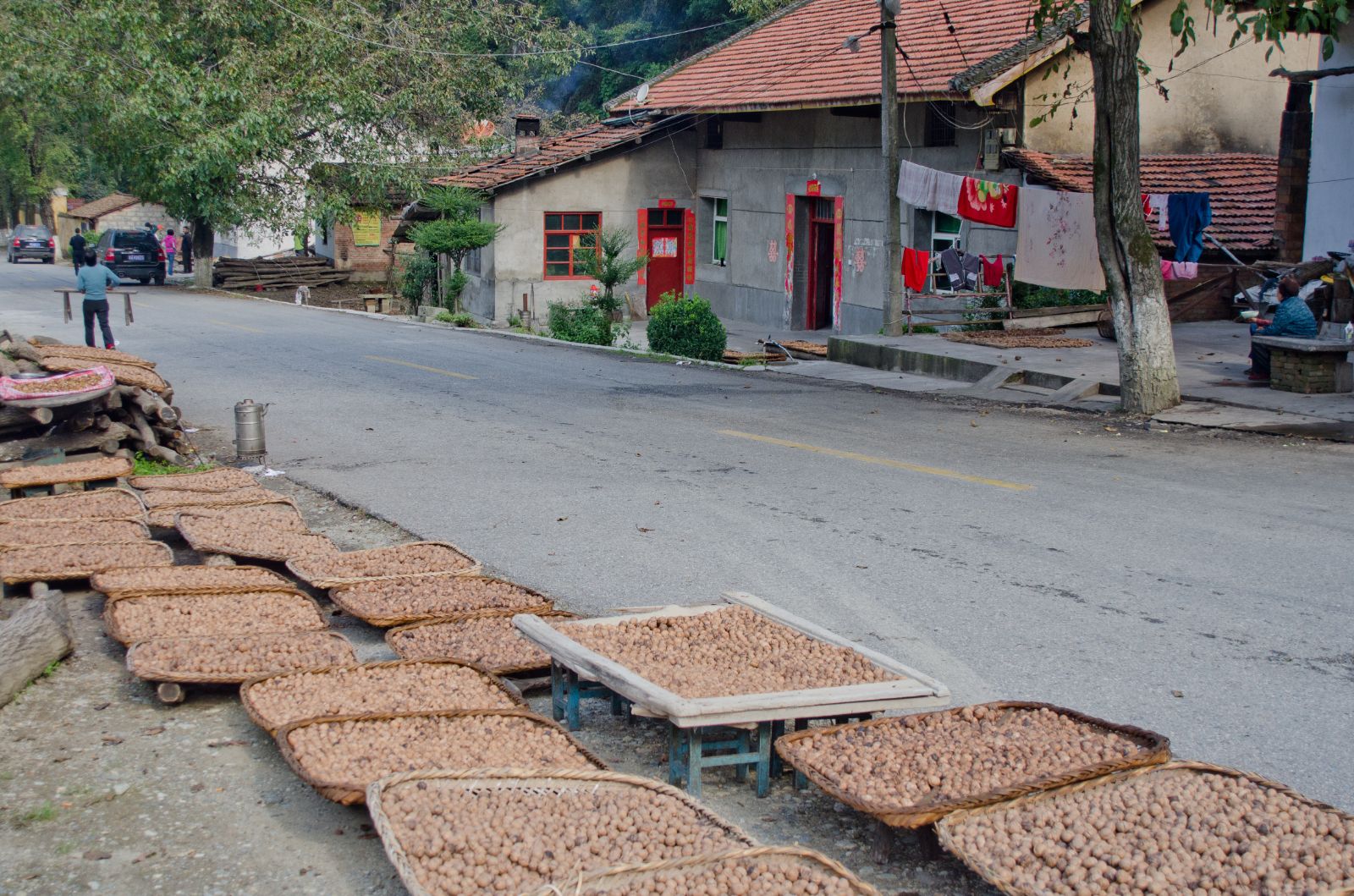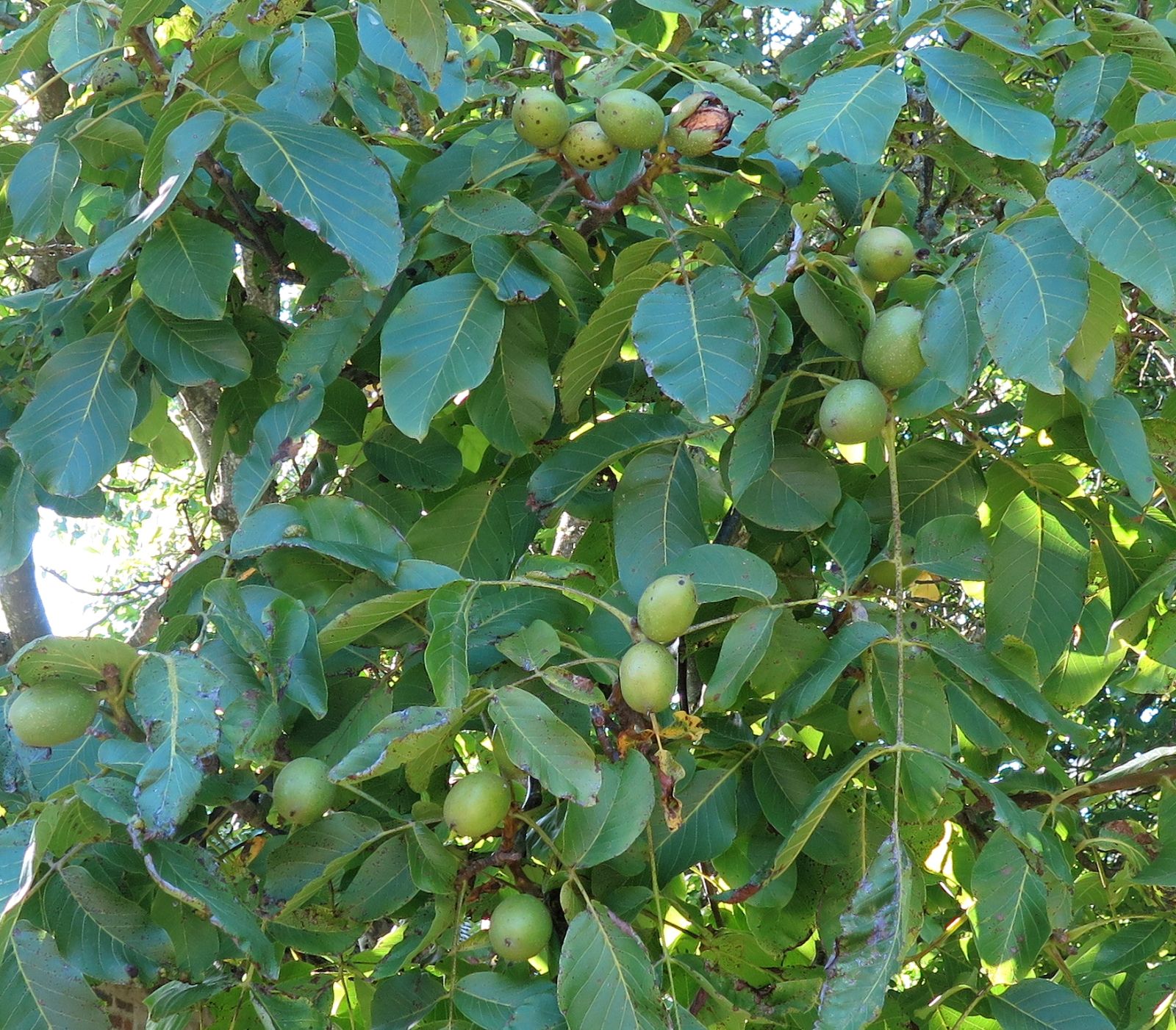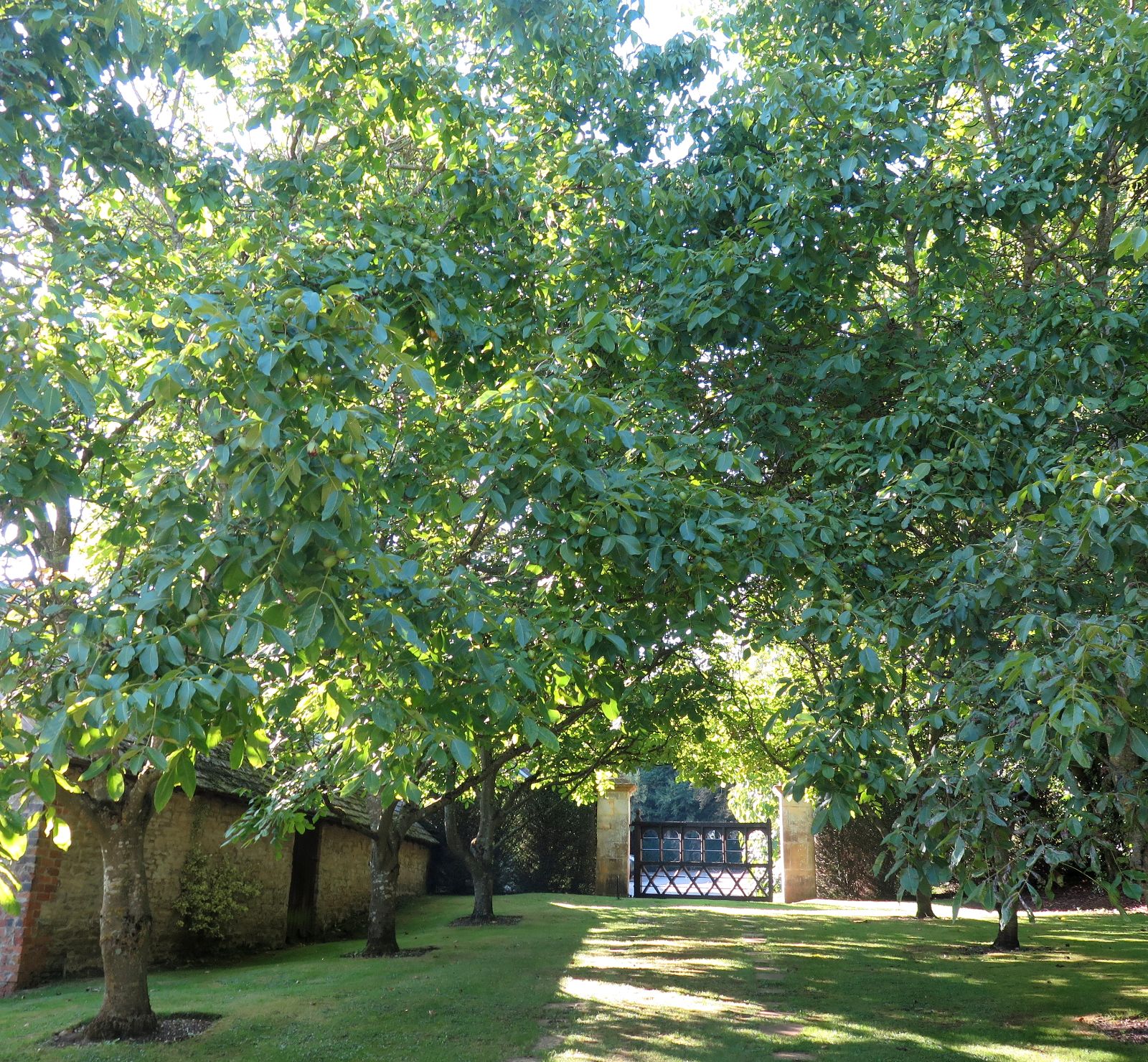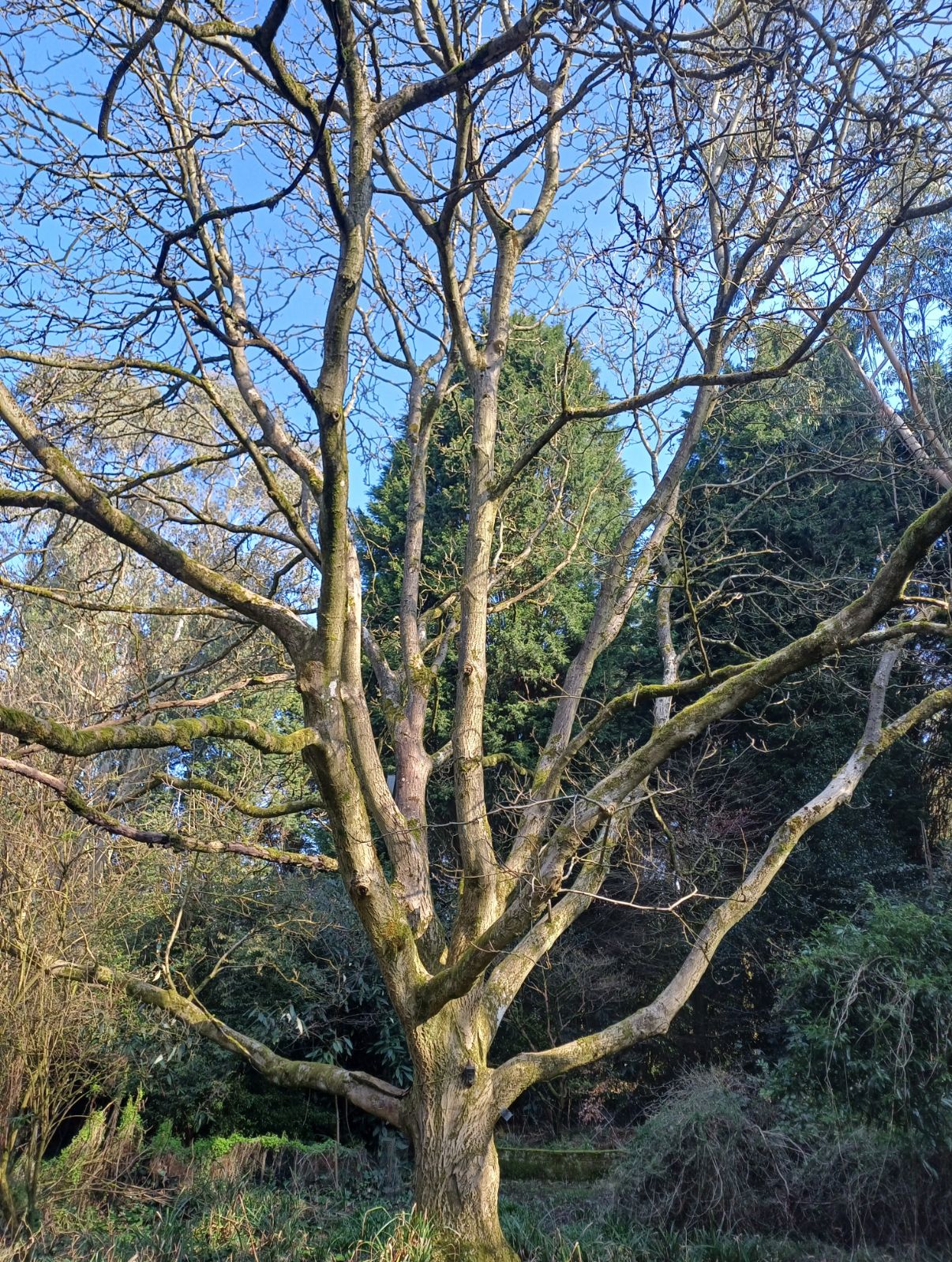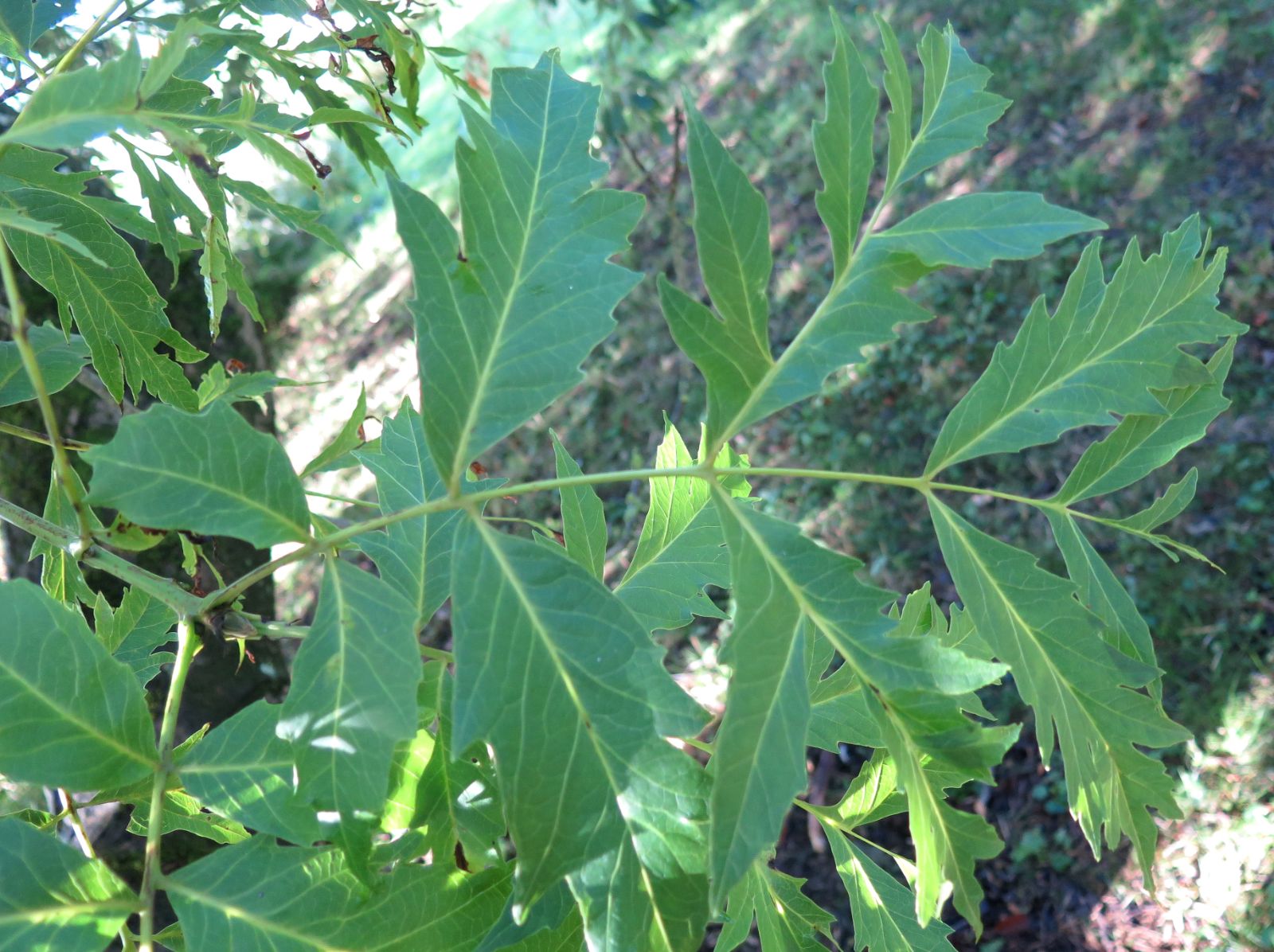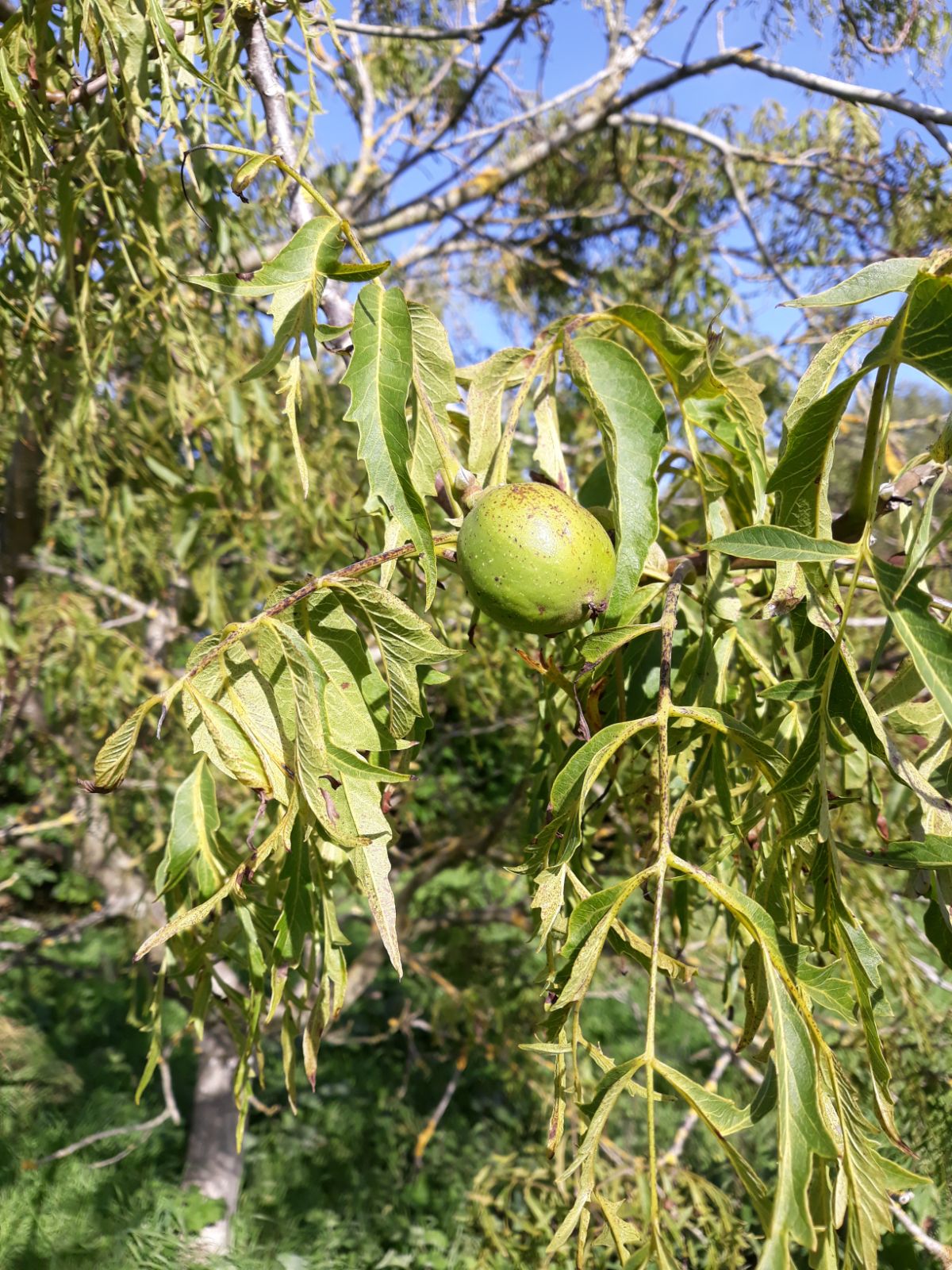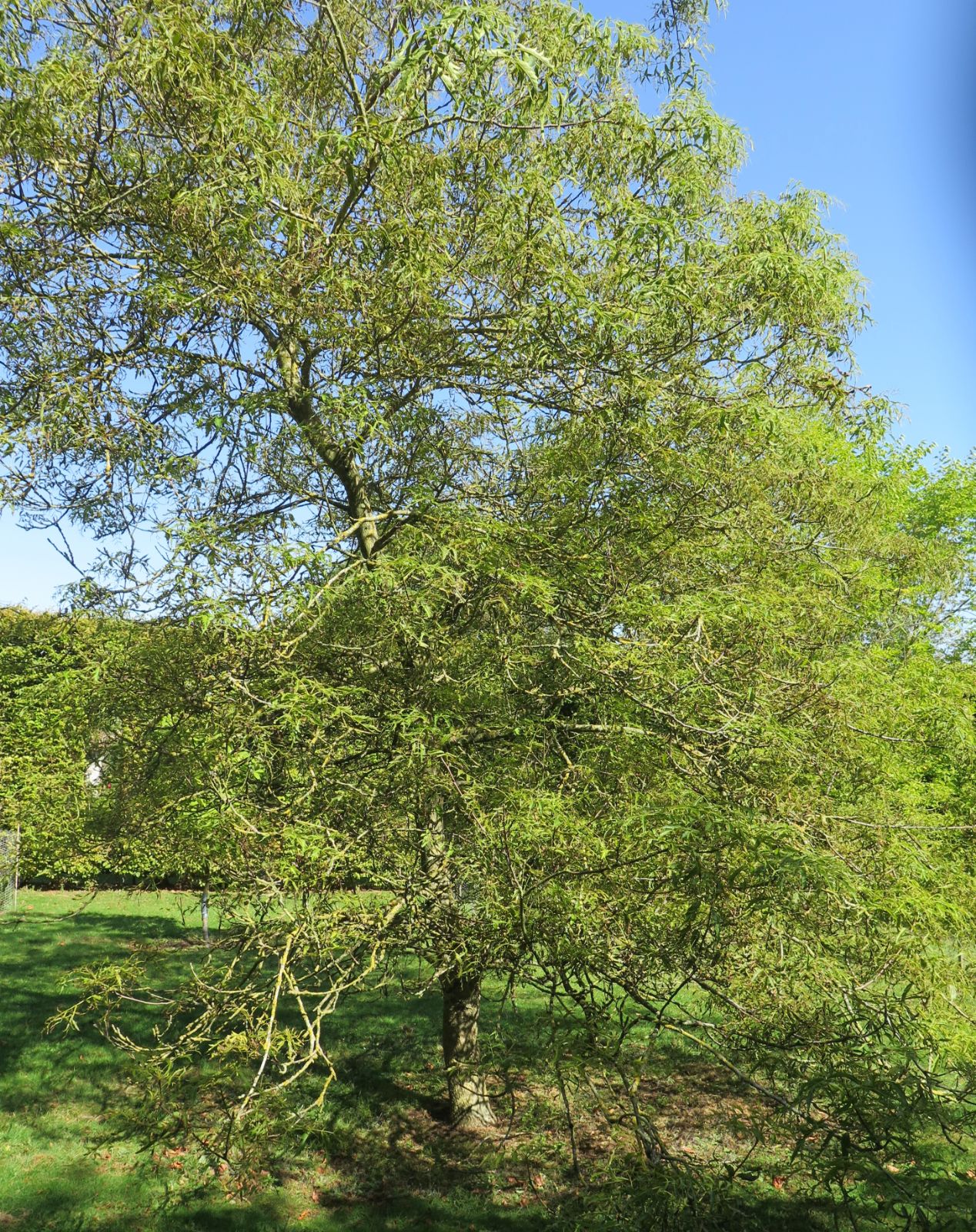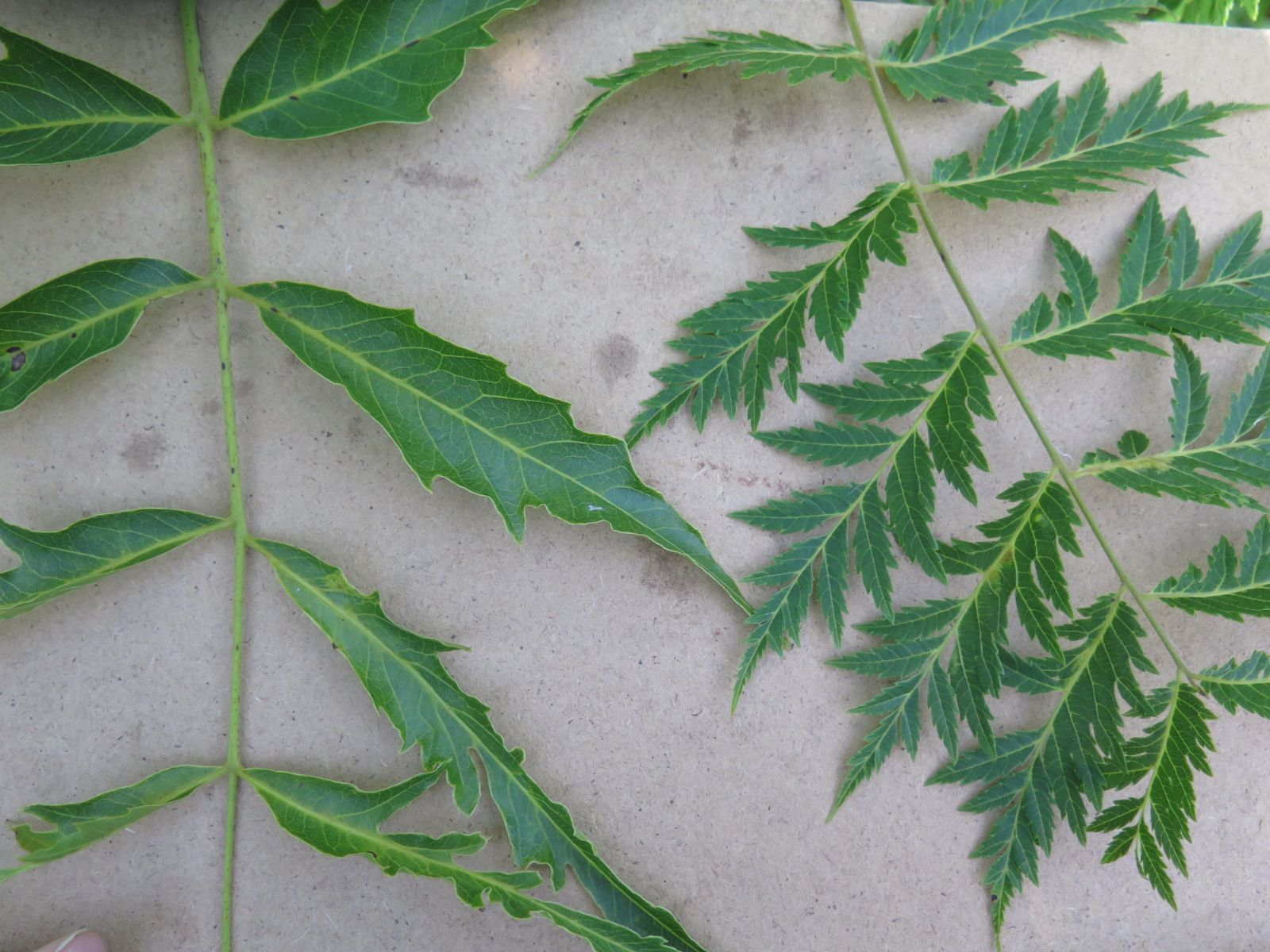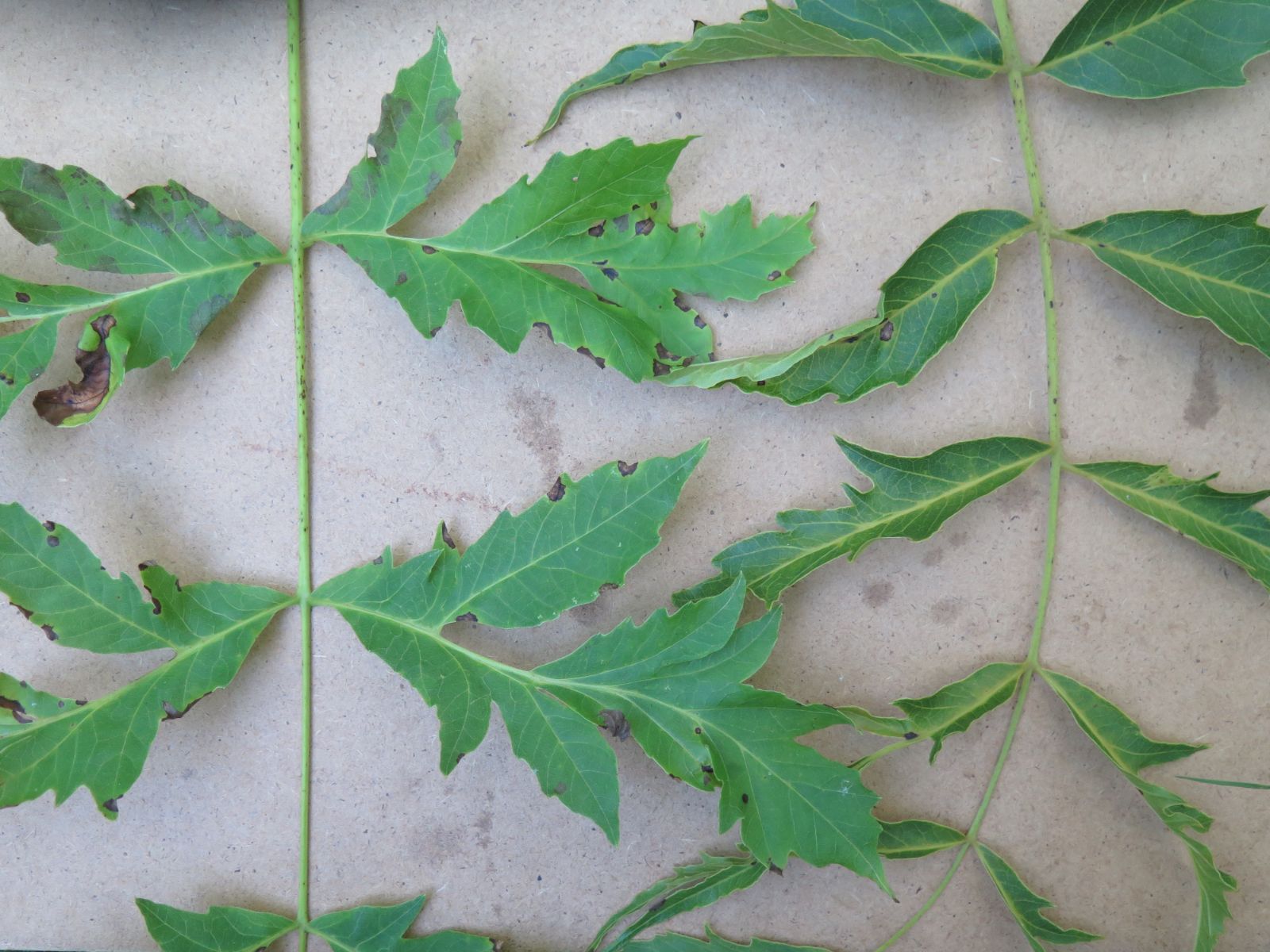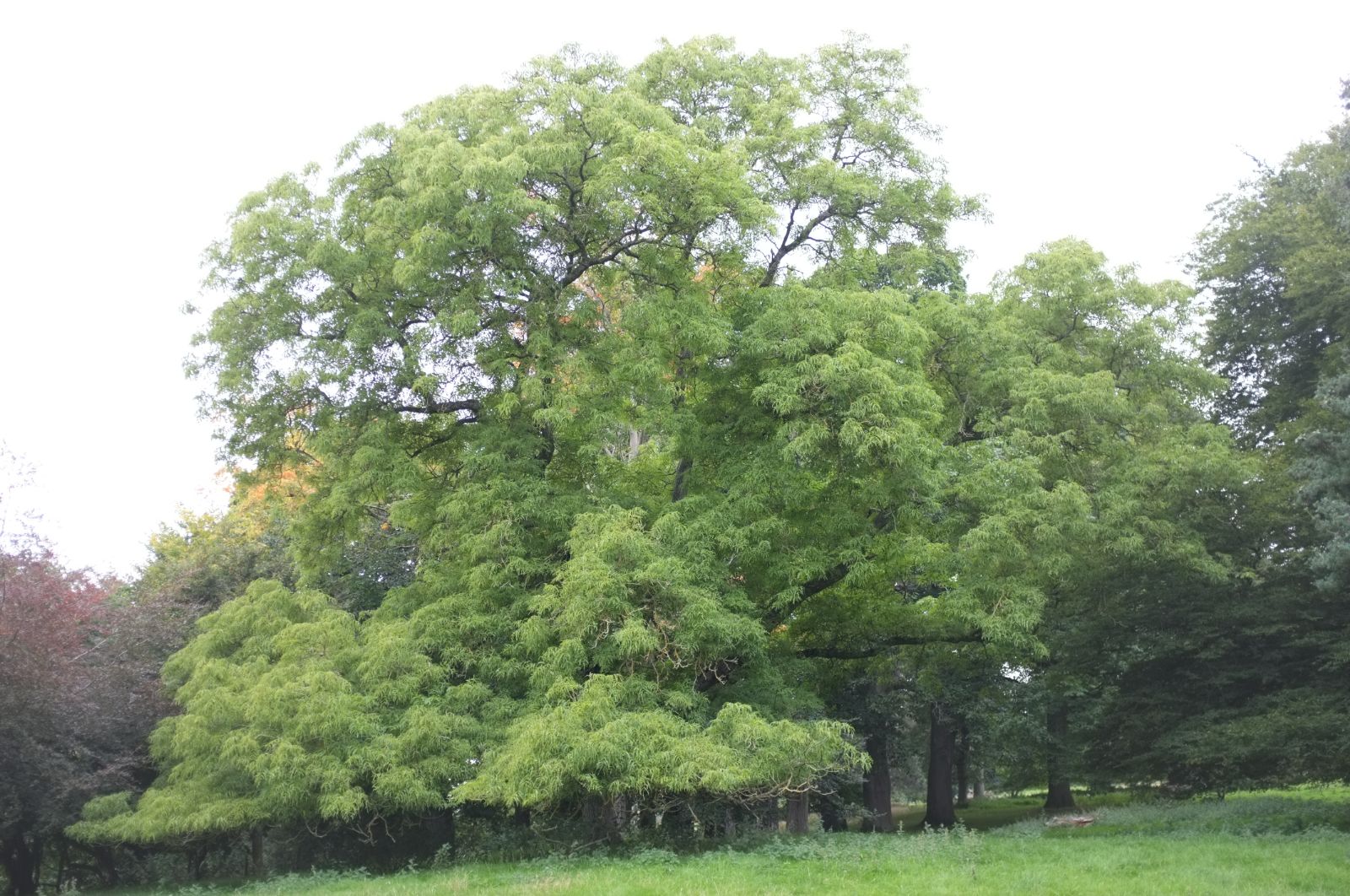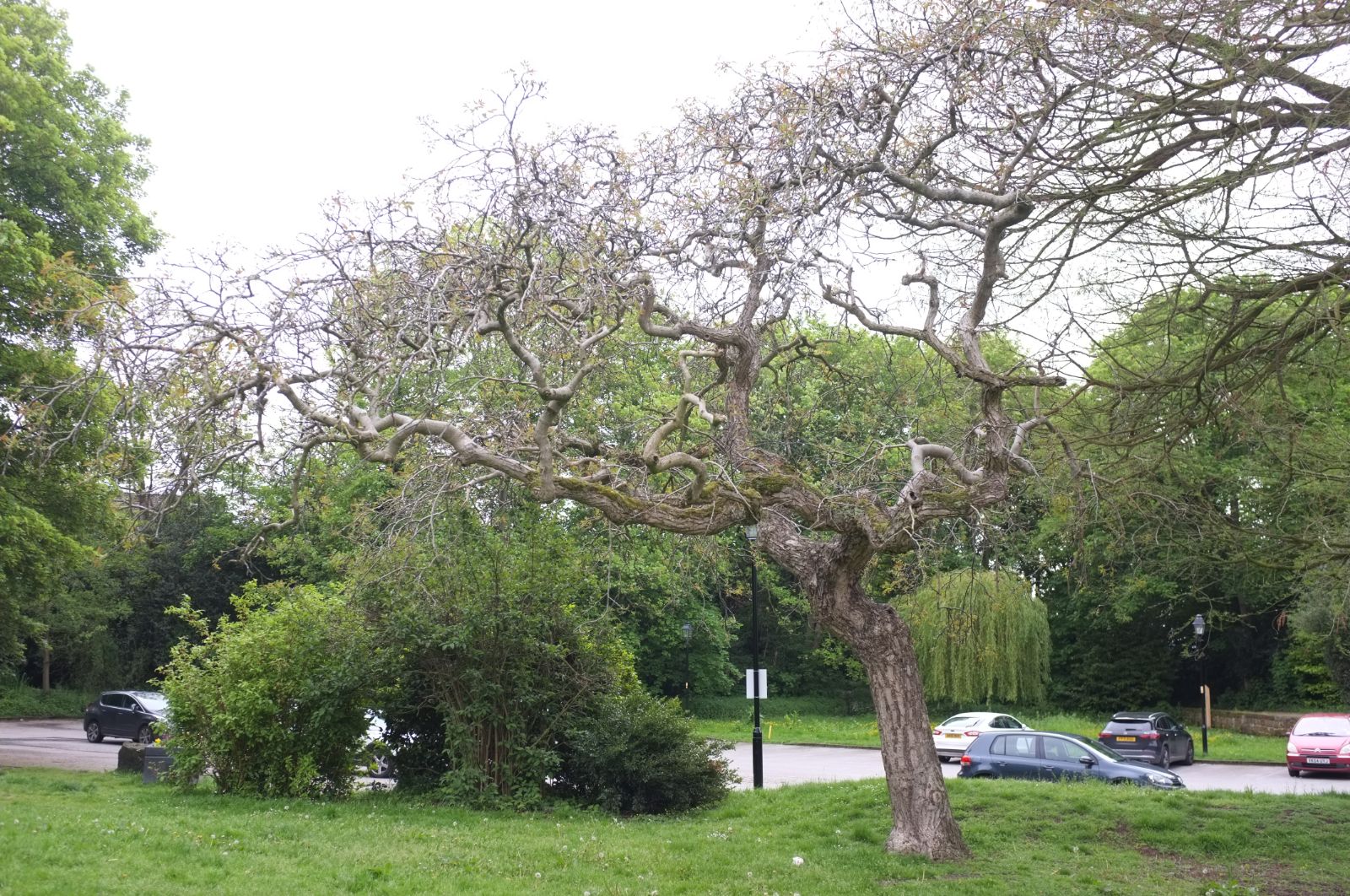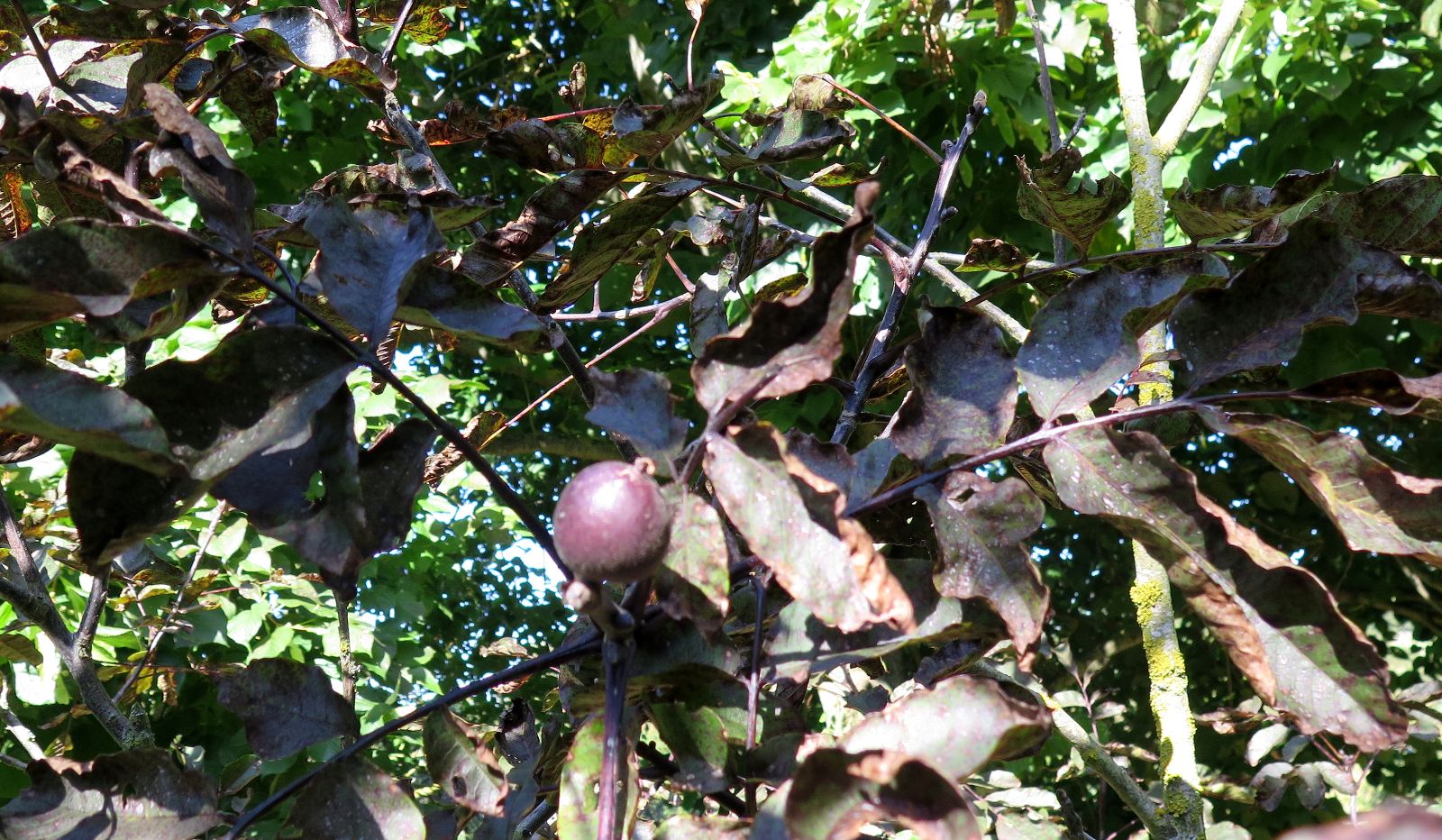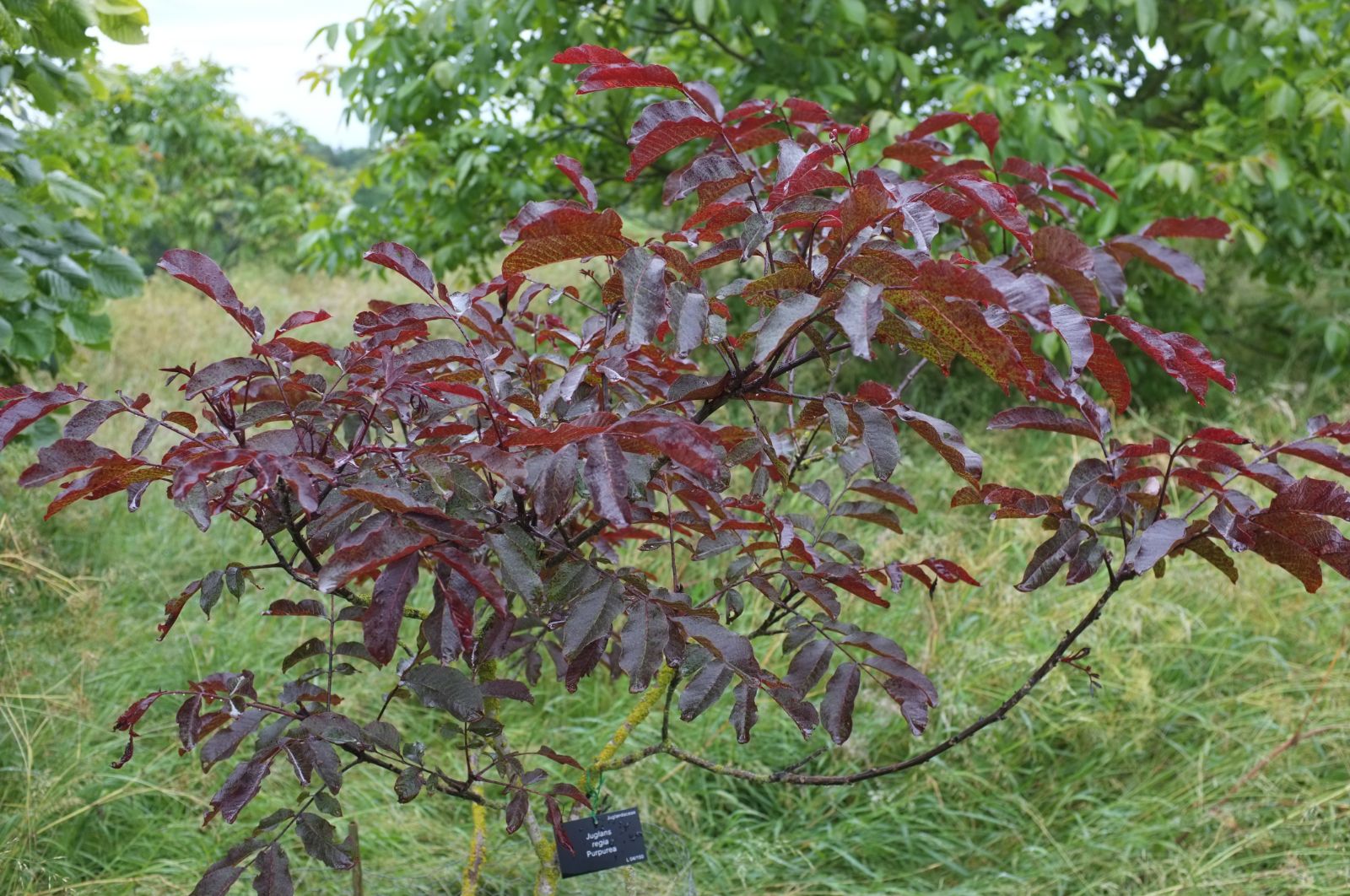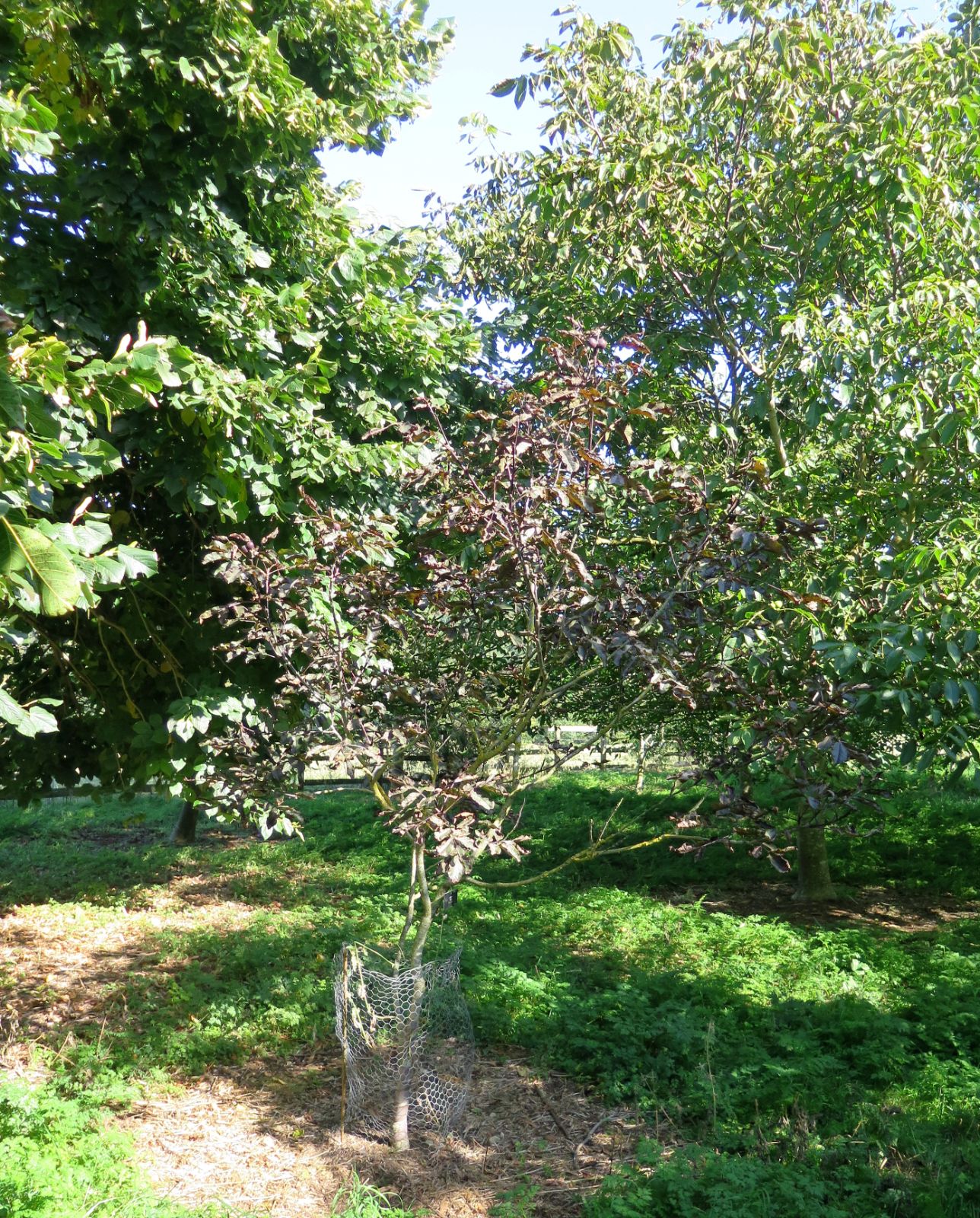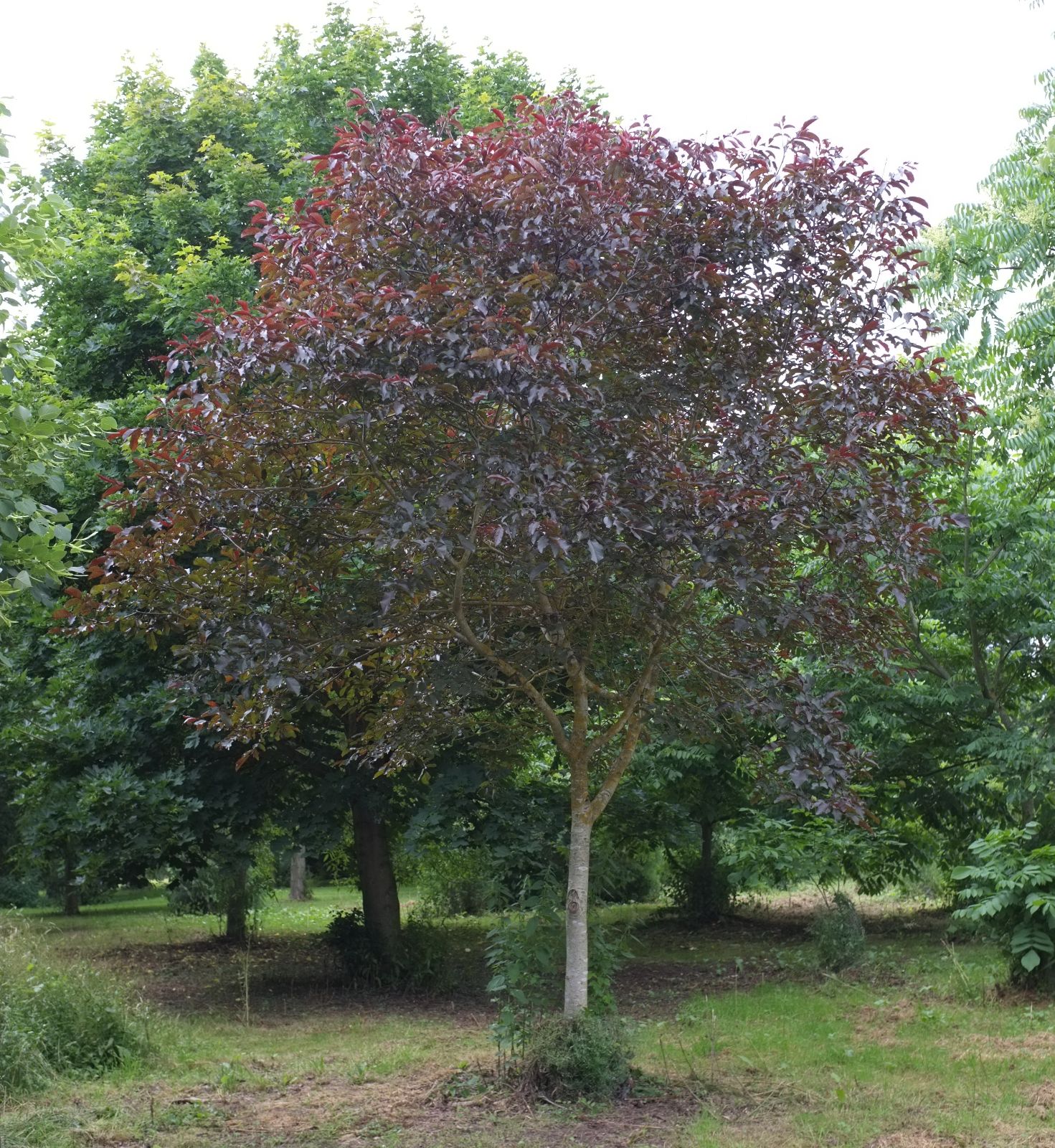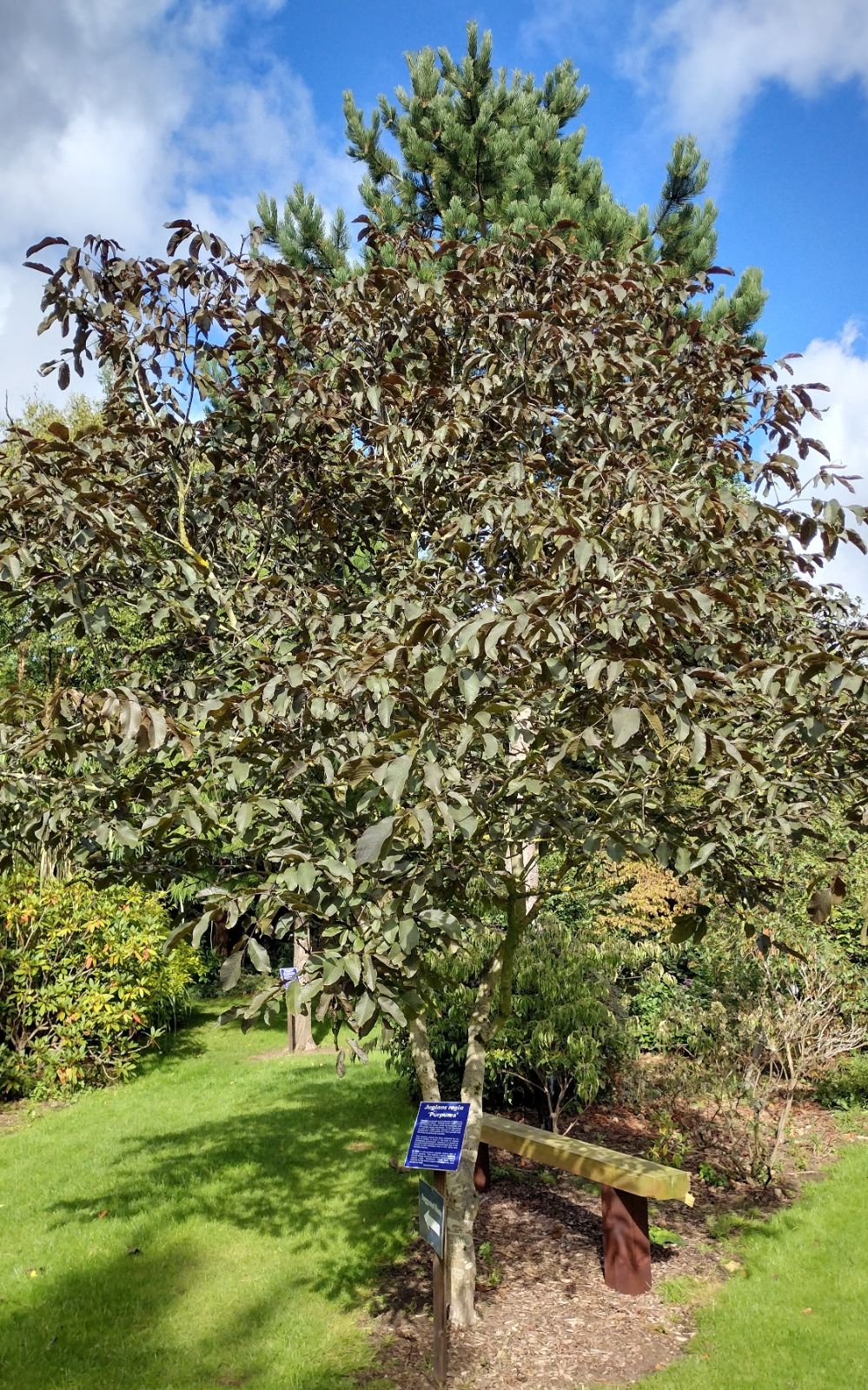Juglans regia
Sponsor
Kindly sponsored by
a member of the International Dendrology Society
Credits
Julian Sutton (2019)
Recommended citation
Sutton, J. (2019), 'Juglans regia' from the website Trees and Shrubs Online (treesandshrubsonline.
Genus
Common Names
- Walnut
- Common Walnut
- Persian Walnut
- English Walnut
- hu tao
Infraspecifics
Other taxa in genus
- Juglans ailantifolia
- Juglans × bixbyi
- Juglans californica
- Juglans cinerea
- Juglans cinerea × mandshurica
- Juglans hindsii
- Juglans hirsuta
- Juglans × intermedia
- Juglans major
- Juglans mandshurica
- Juglans mandshurica × regia
- Juglans Mexican Species
- Juglans microcarpa
- Juglans mollis
- Juglans nigra
- Juglans × notha
- Juglans olanchana
- Juglans Paradox hybrids
- Juglans pyriformis
- Juglans × quadrangulata
- Juglans sigillata
- Juglans × sinensis
- Juglans steyermarkii
Large tree to 25 m with rounded, often open crown. Bark smooth, silvery grey, developing large flat ridges with age. Branchlets stout, olive-brown ageing grey; terminal buds 6–9 mm, pubescent, brownish; pith brown. Leaves 25–30 cm; petiole 5–7 cm; petiole and rachis glabrescent; terminal leaflet present. Leaflets (3–)5–9(–13), usually entire, sometimes obscurely serrulate (and then usually only on young plants); lateral leaflets subsessile or petiolule 1–2 mm, blade elliptic-ovate to long elliptic, 6–15 × 3–6 cm, base oblique, subrounded, apex obtuse or acute to shortly acuminate; terminal petiolule 2.5–6 cm; upper surface glabrous, lower surface glabrous except for tufts of hairs in vein axils. Male spike 5–10(–15) cm. Stamens 6–30(–40). Fruiting spike usually with 1–3 nuts, rarely many more. Fruit subglobose, 4–6 cm; husk glabrous, irregularly dehiscent; nut valvate, valve forming a prominent, longitudinal ridge around the nut, shell otherwise smooth to rugose, and very variable in thickness, especially thin in some cultivars. Flowering April–May, fruit October (China, UK) (Huxley et al.1992; Lu et al.1999; Dirr 2009).
Distribution Pakistan Probably native here, as in Afghanistan, NW India and S Tajikistan; controversially native or introduced from this region east to China and Korea, west to W Europe.
Habitat Forests.
USDA Hardiness Zone 6-9
RHS Hardiness Rating H6
Conservation status Least concern (LC)
The Common Walnut’s story is bound up with our own. Economically significant today for both nuts and timber, historical references to its use go back to 7000 BCE in Persia (Feng et al. 2018). Linnaeus’ specific epithet (from the Latin regius – belonging to a king) implies its value. Beyond its practical uses, it makes an ornamental tree attracting adjectives such as ‘noble’.
The evolutionary origin of Juglans regia and its close relative J. sigillata has only recently become clear. A thorough phylogenomic study (Zhang et al. 2019) shows that they result from ancient hybridisation (about 3.5 MYA) between a black walnut species and a member of the J. mandshurica lineage. Carried and traded across the world for thousands of years, the origin of the present day J. regia distribution is uncertain and controversial. The important genetic and model-based studies of Aradhya et al. (2017) and Feng et al. (2018) provide excellent routes into this difficult area from different starting points, and summarise the literature. Most agree that having been widespread in Eurasia during the Tertiary, the Walnut became restricted to glacial refugia during the coldest episodes of the Pleistocene. Some favour one or a few refugia in southwest Asia; others see evidence for more numerous, scattered refugia, perhaps as far east as northern China and, more contoversially, west to Iberia. Either way, the species has achieved its current range through a mixture of slow natural spread and longer distance human transport. Whether a populations is ‘wild’ or ‘semi-domesticated’ may not be easy to determine, and the term ‘native’ has little meaning here.
The Walnut has diverse uses (Crawford 2016). Nuts are eaten in many ways (Grigson 1973 elegantly samples the diversity of European recipes) and pressed for oil. Immature fruits, before the shell has begun to harden, are pickled in spiced vinegar or used to flavour liqueurs. The timber is used in furniture, gunstocks and – especially from the root crown area – for veneers. Walnut has been used in traditional remedies for diverse ailments and (especially the husks) is a well known dyestuff.
The extent of commercial walnut production illustrates the wide area over which the species can be grown. World production statistics for 2017 (Food & Agriculture Organization of the United Nations 2019) show China responsible for about half the world’s production, followed by the United States (California), Iran, Turkey and Mexico. The remaining 16% of the world’s crop includes all eastern and southern European, plus southern hemisphere (mainly Chilean) production. In our area it can be grown across most of Europe except the far north, and in North America on both the eastern and western seaboards, although crops may be poor in cool maritime areas such as the United Kingdom. There is a great deal of variation in cold hardiness between stocks. Root diseases are a particular problem in North America, where it is normal to graft onto other walnuts, usually Paradox hybrids. Large specimens are frequent in Europe; The Tree Register (2019) shows no particular geographical trend in the United Kingdom. As with other walnuts, sheltered sites are most satisfactory.
Juglans regia shows considerable variation across its range. This has never been – and perhaps could never be – satisfactorily described within a hierarchical taxonomic framework. Arch-splitter Louis-Albert Dode recognised a number of variants (Dode 1906), often based on a single collection. Of those which he treated as full species, J. sigillata survives as a taxon but others have sunk leaving little trace. Sometimes seed is collected under one or another of these names. For example material from HOMC 1907 (Himachal Pradesh, India, 1993), labelled J. kamaonia (C. de Candolle) Dode, grows at Kew (Grimshaw 2004). These trees are distinctive; their large, pendulous leaves have particularly big terminal leaflets, but this is no reason to accept it as a good species. Juglans hopeiensis Hu shows evidence of being a hybrid between J. regia and J. mandshurica (Mu et al. 2017), although these authors feel that it should still be included, along with J. sigillata, in J. regia. This poorly characterised tree from Hebei Province, China, is thought to be the main source of wenwan walnuts and so has an unusual cultural significance. Wenwan walnuts are pairs of carefully matched nuts, selected for aesthetic properties, to be played with in the hand like worry beads; aristocrats have collected wenwan walnuts, and the best pairs are very valuable (Jue 2014).
Thousands of cultivars exist, selected for suitability for particular climates, fertility, yield, kernel size, shell thickness, resistance to various diseases, timing of leaf fall (late fall makes harvesting easier) or production of female flowers from lateral rather than only terminal buds (a significant factor increasing yield). A few are predominantly ornamental. Active breeding work continues in China (although few if any Chinese cultivars are commercially available in our area), California, France and the Middle East (Bernard et al. 2018, an excellent review of scientific walnut breeding).
Most varieties are clearly protandrous or protogynous; both should be grown to ensure pollination. There is some discrepancy between lists of protandrous and protogynous varieties, and without direct observation it is difficult to resolve these; inevitably a good deal of copying between published lists has gone on. Martin Crawford (pers. comm. 2019) notes that male and female flower initiation can be affected differently by the amount of winter chill, and that the order of flowering could potentially be either way round in only slightly differing climates. Here we follow Crawford (2016) except where stated otherwise.
In cool maritime areas such as the United Kingdom, walnut leaf spot is the most troublesome disease, and resistant varieties should be chosen. Here we can only list ornamental varieties and a few of the most significant or widely grown cultivars. For further cultivar information see Crawford (2016), an excellent introduction to smaller scale walnut growing.
'Ames'
Hardy down to Zone 6a and drought tolerant, resistant to walnut blight. Protandrous (Society of Ontario Nut Growers 2013 Grimo Nut Nursery 2019). Mid-season ripening, with large, oval, easily cracked nuts. Selected by Dr Allan Beck from field trials at Iowa State University, Ames, Iowa. Performs well in southern Ontario.
'Broadview'
Widely recommended as a nut variety for the garden in cooler areas, as opposed to seriously commercial production. Hardy (down to Zone 6a in North America), drought tolerant, leafing late, and heavy-cropping from a remarkably young age. Susceptible to walnut blight but resistant to leaf blotch. Protandrous, but reasonably self-fertile and often recommended as a pollinator for protogynous varieties. Nut large, oval, cracking well. Selected by Jack Gellatly of Kelowna in the interior of British Columbia, Canada, around 1930, from nuts sent from Crimea. One of the stars (with ‘Buccaneer’) of a 1960s trial in the Netherlands, it is one of the most widely available cultivars in Europe. Performs well in southern Ontario (Grimshaw 2004; Society of Ontario Nut Growers 2013; Crawford 2016).
Ian Bond, holder of the National Plant Collection of Juglans at Upton Wold, Gloucestershire, when asked for cultivar recommendations replied simply ‘Plant ‘Broadview” (pers. comm. 2019).
'Buccaneer'
A vigorous, upright variety, hardy and leafing late. Resistant to both walnut blight and leaf blotch. Male flowers are carried for a particularly long time, so it is neither protandrous nor protogynous. As a result it is highly self-fertile, and a versatile pollinator for other varieties. Good crops of well-flavoured, round nuts. Raised in the Netherlands, it was one of the stars (with ‘Broadview’) of a 1960s Dutch trial, and is widely available in Europe (Grimshaw 2004; Crawford 2016).
'Chandler'
Moderately hardy, this is a heavy cropping lateral bearer, resistant to both walnut blight and leaf blotch. It is protandrous but partially self-fertile. The nuts are thin shelled, with a high (approximately 50%) yield of light-coloured kernels. Introduced in 1979 from the breeding program of the University of California, Davis, its parents were the older Californian cultivar ‘Payne’ and a French variety. It was named for W.H. Chandler, Professor of Pomology at U.C. Davis. This variety currently forms the backbone of the Californian walnut industry, providing over 70% of the state’s crop in recent years (Crawford 2016; Bernard et al. 2018).
'Coble 2'
Hardy down to Zone 6b, productive but susceptible to walnut blight. Protandrous. Very large, thin shelled, reasonably well-filled nuts; the kernels lack all bitterness. A recent American variety introduced by Garnet Coble in Pennsylvania. Performs well in southern Ontario (Society of Ontario Nut Growers 2013; Crawford 2016).
'Combe'
Hardy down to Zone 6a, drought tolerant, cropping heavily and annually. Highly resistant to walnut blight. Leaves drop well after the nuts, aiding harvest. Protandrous (Society of Ontario Nut Growers 2013). Introduced from Utah by Clifford Dabb. Good quality, oval, medium-sized nuts. Performs well in southern Ontario (Society of Ontario Nut Growers 2013; Crawford 2016).
f. fragilis K. Koch
Synonyms
Juglans regia var. tenera Loud
The name refers to very thin-shelled forms, so thin that they can be easily pierced by birds. Bean (1981) noted the English and French names Thinshelled Walnut, Titmouse Walnut, Noyer à Coq tendre and Noyer Mésange. While shell thickness varies greatly among the cultivars grown today, this name is rarely seen and we it include it here because of its use in older literature.
f. macrocarpa K. Koch
Synonyms
Juglans regia var. maxima Loud
Forms distinguished by extremely large, thin shelled nuts are classified here. The kernels prove disappointingly small. They are known in France as noyer à bijoux because the shells are traditionally used to make little jewel boxes (for photographs and an online tutorial see Anon. 2019). (Bean 1981).
f. monophylla (C. DC.) Schneid.
Synonyms
Juglans regia var. monophylla C. DC
Not so much an ornamental variety as a curiosity, with simple leaves, or sometimes a large terminal leaflet and one pair of small lateral leaflets. Leaf shape ranges on a single shoot from broadly ovate with a cordate base to narrowly lanceolate. It arose as a chance seedling near Dieppe, France in 1833. The original is long gone, and specimens are very rarely seen today, on either side of the Atlantic (Lake 1913; Bean 1981). There is a tree in the Glasnevin National Botanic Garden, Dublin, measured at 5 m × 11 cm in 2012 (The Tree Register 2019).
f. prepaturiens (Pepin) Rehd.
An old name relating to precocious fruiting varieties. The name was first given to a plant was raised around 1830 by the French nurseryman Chatenay, of Doué, Maine-et-Loire, who found it bearing fruit in a bed of three-year-old seedlings. Its seedlings were said to be more or less true to type and bear fruit when less than 3 ft high (Bean 1981). While such precocity is valued in modern selections such as ‘Broadview’, the name is rarely used today and is included here for historical reasons.
f. racemosa (C. DC.) Schneid.
Synonyms
Juglans regia var. racemosa C. DC
Older literature records under this name forms with full-sized fruits in clusters of eight to fifteen (Lake 1913; Bean 1981), known in orchards as Cluster Walnut or Noyer à grappe. Lake (1913) believed that it originated in Belgium and was introduced to the United States in the 19th century by French-Californian nurseryman Felix Gillet. Both these authors clearly believed that it was a form of J. regia; if it still exists, it might prove ornamental in fruit.
f. rubra Hort
Varieties with red-skinned kernels (sometimes used as a novelty in confectionary) are classified here; the form is said to have originated in Austria. The best known such variety is the lateral-bearing ‘Red Danube’ (= ‘Rode Danau’). The pigmentation does not extend to other parts of the plant: for a purple-leaved cultivar, see ‘Purpurea’ (Bean 1981; Crawford 2016).
'Ferjean'
A moderately hardy lateral bearer, cropping heavily from an early age. Resistant to both walnut blight and leaf blotch. Protandrous. The nuts have rather small kernels. One of three cultivars listed here from Unité de Recherche sur les Espèces Fruitières et la Vigne in Bordeaux (all have the ‘Fer-’ prefix; three even newer cultivars are still less widely available). ‘Ferjean’ was introduced in 1999; its parents were ‘Grosvert’ and ‘Lara’ (Crawford 2016; Bernard et al. 2018).
'Fernette'
A moderately hardy lateral bearer, quite vigorous and cropping well. Resistant to both walnut blight and leaf blotch. Protogynous, said to be a good pollinator. Nuts large and rounded. Introduced in 1995 by Unité de Recherche sur les Espèces Fruitières et la Vigne, its parents were ‘Franquette’ and ‘Lara’ (Crawford 2016; Bernard et al. 2018).
'Fernor'
A moderately hardy lateral bearer, quite vigorous and cropping heavily. Resistant to both walnut blight and leaf blotch. Protandrous. Nuts large. Introduced in 1995 by Unité de Recherche sur les Espèces Fruitières et la Vigne, its parents were ‘Franquette’ and ‘Lara’, as with ‘Fernette’ (Crawford 2016; Bernard et al. 2018).
'Franquette'
Awards
AGM
A rather hardy, late leafing variety, vigorous-growing and reasonably heavy-cropping. Resistant to both walnut blight and leaf blotch. Protandrous. Nuts quite large. An old French commercial variety, discovered in the early 18th century and still responsible for around 70% of French production; it is easily obtainable in Europe and holds the Royal Horticultural Society’s Award of Garden Merit (Crawford 2016; Bernard et al. 2018).
'Hansen'
An extremely hardy, lateral bearing variety, making a smaller tree; it crops well at a young age. Resistant to walnut blight. Protandrous. Nuts relatively small, but kernel yield up to 60%. The most famous of the cold tolerant ‘German’ walnuts, introduced into commerce in 1952 from a tree in Ohio, which was probably grown from German seed in the 19th century. A celebrated variety in the northeastern United States and Canada. (Goodell 1984; Crawford 2016).
'Laciniata'
A decorative form with deeply cut leaflets; there are usually rather more leaflets than in wild type Walnut. Relatively slow-growing, it usually makes a small to medium sized tree, which rarely or never produces nuts. It can become rather tatty late in the season, especially if affected by leaf blotch. ‘Laciniata’ originated in the early 19th century, and holds the RHS Award of Garden Merit. ‘Leopold’ is rather similar, as was the older French ‘Heterophylla’ (perhaps defunct). None of these makes so beautiful a foliage tree as J. nigra ‘Laciniata’ (Bean 1981; De Smallekamp 2015).
Large specimens in the United Kingdom include trees at Hergest Croft, Herefordshire (15 m × 76 cm, 2013) and Llanover Park, Monmouthshire (14 m × 51 cm, 2017) (The Tree Register 2019). Never common in the United Kingdom, it is rarely grown in North America despite having been in commerce since the 1890s (Jacobson 1996).
'Lara'
A hardy, less vigorous, lateral bearing variety, cropping well but susceptible to walnut blight. Protandrous. Large, sweet nuts. A 20th-century French cultivar holding the RHS Aaward of Garden Merit (Crawford 2016).
'Mini Multiflora 14'
Perhaps the most easily obtained of the modern dwarf walnuts, suitable for small gardens, reaching a maximum height of 3–4 m. Self-fertile, an important feature when only one walnut is grown. Selected in the Netherlands (Crawford 2016). Other dwarfs include ‘Europa’, ‘Dwarf Karlik 3’ and ‘Dwarf Karlik 5’.
'North Platte'
A very cold- and drought-tolerant variety, in North America productive in Zone 6b and probably lower; vigorous, heavy cropping and resistant to walnut blight. Protogynous. Nuts medium to large, oval, cracking well. Leaves hold well until after harvest. Introduced from North Platte, Nebraska (Zone 5a) (Society of Ontario Nut Growers 2013; Crawford 2016).
'Parisienne'
A vigorous, hardy, late leafing variety, resistant to both walnut blight and leaf blotch. Protandrous. Fairly large, conical nuts. An old French variety (Crawford 2016).
'Pendula'
Pendulous forms, rarely seen, are normally placed here, but may not represent a single clone. Some may not even be especially pendulous.
According to Bean (1981) the name belongs to a pendulous variety which was grown by the French nurseryman Armand Gothier of Fontenay-aux-Roses, who brought it from Waterloo in Belgium in 1850. He also reports that a small pendulous tree at Kew came from the nurseryman Lee of Hammersmith shortly before 1880. The Tree Register (2019) does not record any current British specimens of significant size.
Lake (1913) describes a specimen under this name in the grounds of the US Department of Agriculture as ‘sprawling, somewhat pendulous’ and scathingly comments that hundreds of young orchard walnuts he had seen in California afforded ‘a far greater display of long, slender, pendulous branches’.
Photographs of a specimen in the Botanischer Garten Bonn, Germany (monumentaltrees.com 2019) show a tree which is not strikingly pendulous. In contrast, the Hamburg nursery Klocks describes the branches as often hanging down to the ground (Klocks 2019).
'Purpurea'
A slow-growing variety, reaching only 5 m or so in height. The leaves emerge glossy red, maturing to dull purple. The twigs and fruits, when produced, are also purple (van den Berk Nurseries 2019). The Tree Register (2019) records several British specimens of 5–6 m, including one at the Sir Harold Hillier Gardens, Hampshire.
'Sejnovo'
Hardy down to Zone 6b, drought tolerant, productive and resistant to walnut blight. Leaves drop well after the nuts, aiding harvest. Protandrous. Nuts large, oval and easily cracked. A rather widely grown selection, originally from Bulgaria. Performs well in southern Ontario (Society of Ontario Nut Growers 2013; Crawford 2016).
'Youngs B1'
Hardy down to Zone 6a, drought tolerant, vigorous and cropping well annually. Resistant to walnut blight. Leaves tend to drop after the nuts, aiding harvest. Protogynous. Nuts large, round with high kernel yield. A ‘Broadview’ seedling selected by Earl Young of Lyons, New York. Performs well in southern Ontario (Society of Ontario Nut Growers 2013; Crawford 2016).

